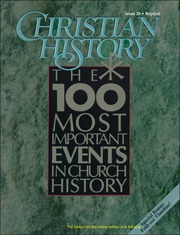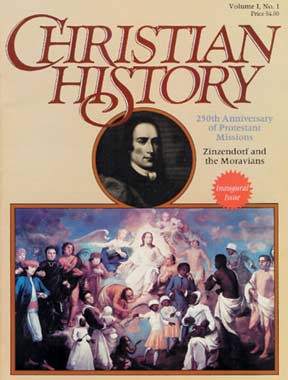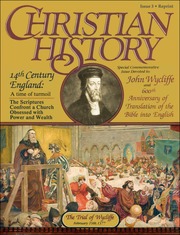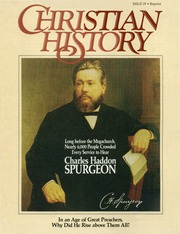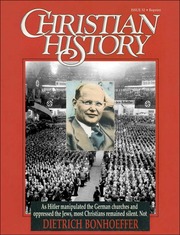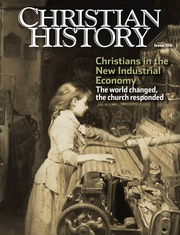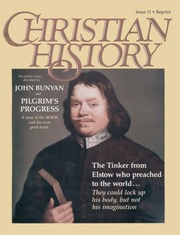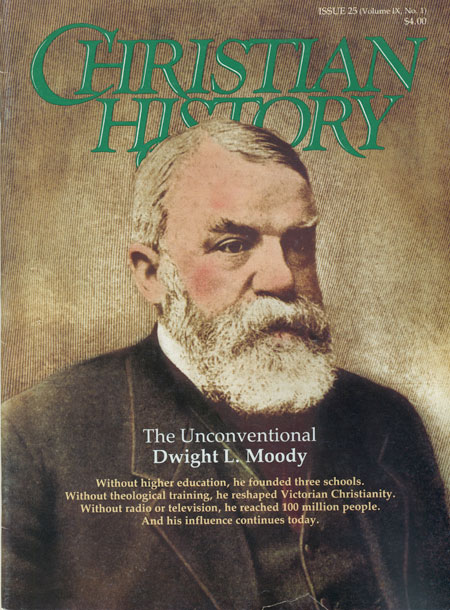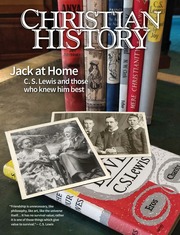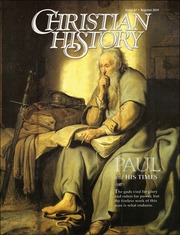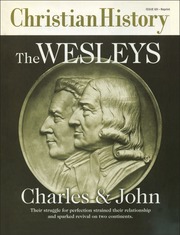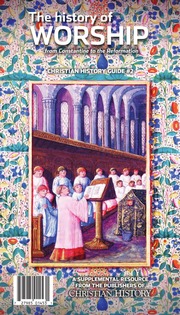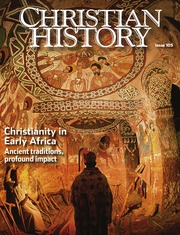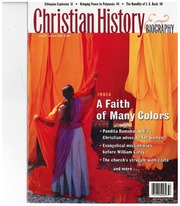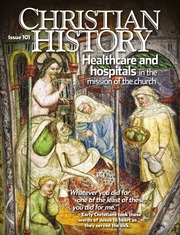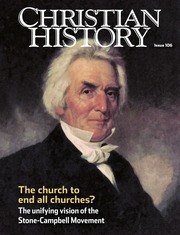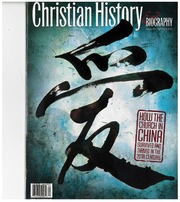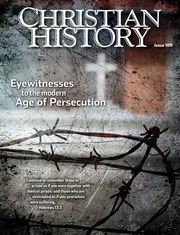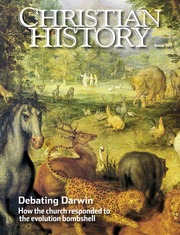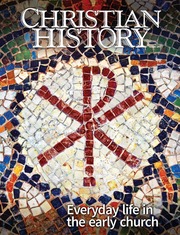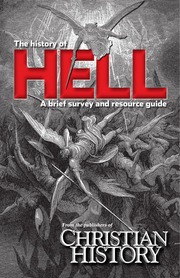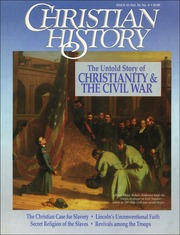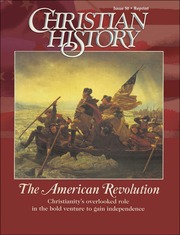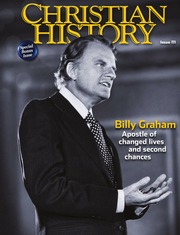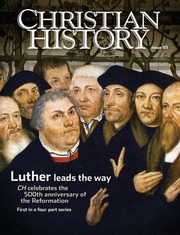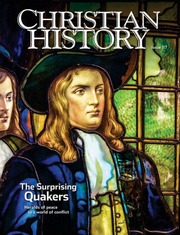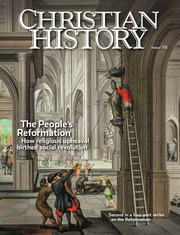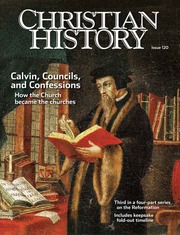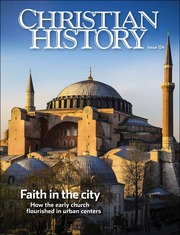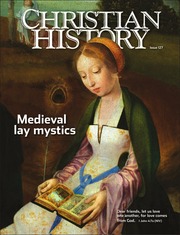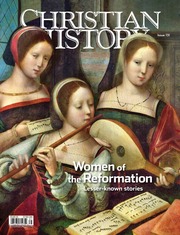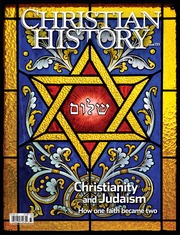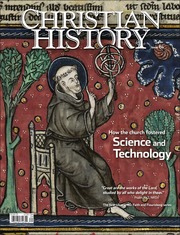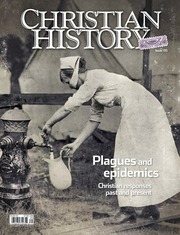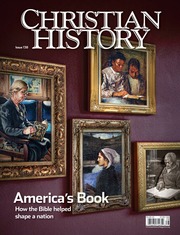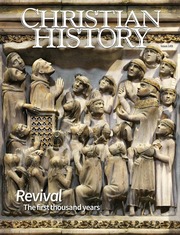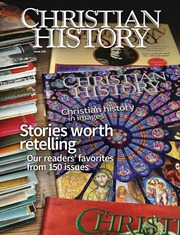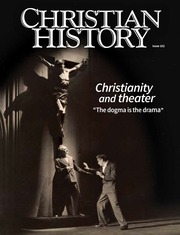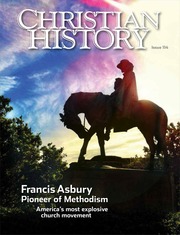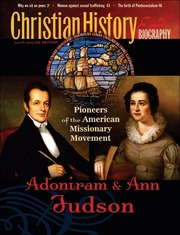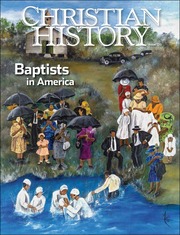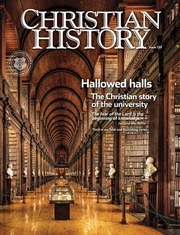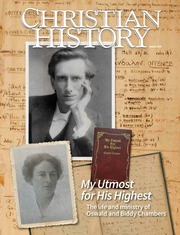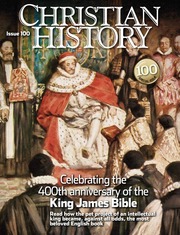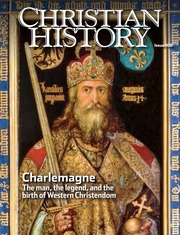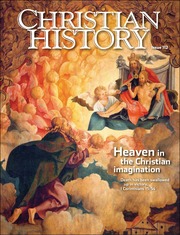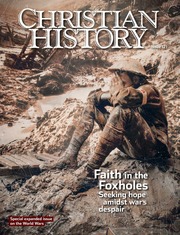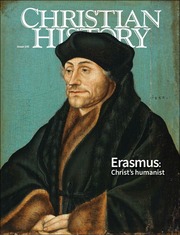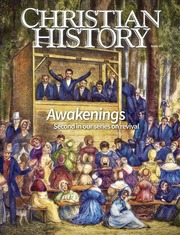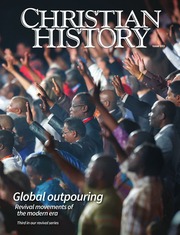Many (but not all) the magazines listed below are available on Archive.org and have no restrictions. The publisher Christian History Institute is a non-profit organization and I highly recommend subscribing to Christian History Magazine for their edifying and inspiring articles. Click here for more information. The titles below are accompanied by a short excerpt but if a topic interests you, I would strongly recommend reading the entire issue for that topic. You will definitely learn something about the topic you did not know. The articles are replete with many excellent illustrations and pictures.
100 Most Important Events in Church History - Christian History Magazine #28
Welcome to This Special Issue - Important information before you begin. This issue is a first for CHRISTIAN History. For twenty-seven issues, we have focused on particular individuals, movements, or events. But never have we stepped back to look at the broad, two thousand-year sweep of Christian history. We have looked at individual trees— grand oaks such as Augustine and Calvin—but not the forest.
The very idea seemed overwhelming. How could we possibly present an overview of church history in one issue? Latourette’s classic A History of Christianity requires 1,552 pages of fine print to accomplish the same.
Yet readers had asked for an issue that would orient them to church history, an introductory guide that might be used in classes or discussion groups. And we wanted to show how the diverse figures covered in previous issues of CuristiAN History—Bernard of Clairvaux, John Wesley, and C. S. Lewis, to name three—fit into the sweep of history. By understanding each person’s context, we can better understand his or her contribution.
I discussed these ideas with Christian History's founder, Dr. Ken Curtis, and he mentioned a book he was planning: The 100 Most Important Events in Church History. The idea made sense for the magazine, too. Perhaps we couldn’t draw a detailed map for every mile of the church’s journey, but we could sketch the most significant landmarks, milestones, and turns in the road. The Council of Nicea, Luther's posting of The Ninety-Five Theses, John and
Charles Wesley's conversions—these events clearly changed the course of church history. In highlighting these key events, we hoped, we could help people see the big picture, the development and change of the Christian church over time. The project would be an adventure, but we felt it was worth the risk.
How were the events selected? Selecting only one hundred key events from church history is not easy. We felt as if we had been given only an afternoon to tour the Louvre, probably the finest collection of paintings in the world. Where do you start, when the museum holds works by Vermeer, Rubens, El Greco, Raphael, and Titian?
Still, a qualified tour guide could show you what are generally considered the more significant works: Rembrandt’s The Supper at Emmaus, or Leonardo da Vinci's Mona Lisa. This issue of Christian History aims to be a similar guide through a history filled with treasures.
To determine the dates deserving coverage, extensive research was done by the Christian History Institute and by Christianity Today, Inc. First, a survey was sent to members of the Christian History Institute. Responses were tabulated, the list of events was refined, and a new survey was written.
This was sent to five hundred members of a professional church historians’ society. The group represented a dazzling array of denominations, theological positions, and areas of historical study. Seventy-one percent of respondents hold doctoral degrees.
The survey listed nearly 150 events in church history— the Diet of Worms, the Second Vatican Council, and so on—and asked respondents to mark whether each event was “extremely important,” “very important,” ‘‘somewhat important,” “not too important” (or “not familiar’ to them). The survey also invited respondents to suggest other church-history dates they considered extremely important.
Finally, the survey was sent to the editorial advisory board of CuristiAN History. These historians completed the survey and suggested still other events worthy of inclusion.
Survey results were tabulated, and “write-in’’ events were thoughtfully compared and evaluated. From this information, a list of the 100 most important events in church history was compiled. (And from that, a list of the 25 most important dates.)
We found the list interesting, educational—and at least in a few places, surprising.
The Most Important Events in Church History (SEE FULL COLOR TIMELINE OF IMPORTANT EVENTS)
- Titus Destroys Jerusalem
- The “Edict of Milan’
- The First Council of Nicea
- Athanasius Defines the New Testament Canon Augustine Converts to Christianity
- Augustine Converts to Christianity
- Jerome Completes the Vulgate
- The Council of Chalcedon
- Benedict Writes His Monastic Rule
- Vladimir Adopts Christianity/“Christianization of Russia”
- The East-West Schism
- Pope Urban II Launches the First Crusade
- Thomas Aquinas Concludes Work on Summa Theologiae
- The Great Papal Schism
- Gutenberg Produces the First Printed Bible
- Luther Posts the Ninety-five Theses
- The Diet of Worms
- The Anabaptist Movement Begins
- The Act of Supremacy
- Calvin Publishes Institutes of the Christian Religion
- The Council of Trent Begins
- Publication of the King James Bible
- John and Charles Wesley Experience Conversions (THIS IS FASCINATING READING)
- The Great Awakening
- The Second Vatican Council
- Martin Luther King, Jr., Leads the March on Washington.
Christian History Magazine #1 - Zinzendorf and the Moravians
A Prayer Meeting that Lasted 100 Years by LESLIE K. TARR
FACT: The Moravian Community of Herrnhut in Saxony, in 1727, commenced a round-the-clock “prayer watch” that continued nonstop for over a hundred years.
FACT: By 1791, 65 years after commencement of that prayer vigil, the small Moravian community had sent 300 missionaries to the ends of the earth.
Could it be that there is some relationship between those two facts? Is fervent intercession a basic component in world evangelization? The answer to both questions is surely an unqualified “yes.”
That heroic eighteenth-century evangelization thrust of the Moravians has not received the attention it deserves. But even less heralded than their missionary exploits is that hundred-year prayer meeting that sustained the fires of evangelism.
During its first five years of existence the Herrnhut settlement showed few signs of spiritual power. By the beginning of 1727 the community of about three hundred people was wracked by dissension and bickering. An unlikely site for revival!
Zinzendorf and others, however, covenanted to prayer and labor for revival. On May 12 revival came. Christians were aglow with new life and power, dissension vanished and unbelievers were converted.
Looking back to that day and the four glorious months that followed, Zinzendorf later recalled: “The whole place represented truly a visible habitation of God among men.”
A spirit of prayer was immediately evident in the fellowship and continued throughout that “golden summer of 1727,” as the Moravians came to designate the period. On August 27 of that year twenty-four men and twenty-four women covenanted to spend one hour each day in scheduled prayer.
Some others enlisted in the “hourly intercession.”
“For over a hundred years the members of the Moravian Church all shared in the ‘hourly intercession.’ At home and abroad, on land and sea, this prayer watch ascended unceasingly to the Lord,” stated historian A. J. Lewis.
The Memorial Days of the Renewed Church of the Brethren, published in 1822, ninety-five years after the decision to initiate the prayer watch, quaintly describes the move in one sentence: “The thought struck some brethren and sisters that it might be well to set apart certain hours for the purpose of prayer, at which seasons all might be reminded of its excellency and be induced by the promises annexed to fervent, persevering prayer to pour out their hearts before the Lord.”
The journal further cites Old Testament typology as warrant for the prayer watch: “The sacred fire was never permitted to go out on the altar (Leviticus 6:13); so in a congregation is a temple of the living God, wherein he has his altar and fire, the intercession of his saints should incessantly rise up to him.”
That prayer watch was instituted by a community of believers whose average age was probably about thirty. Zinzendorf himself was twenty-seven.
The prayer vigil by Zinzendorf and the Moravian community sensitized them to attempt the unheard-of mission to reach others for Christ. Six months after the beginning of the prayer watch the count suggested to his fellow Moravians the challenge of a bold evangelism aimed at the West Indies, Greenland, Turkey and Lapland. Some were skeptical, but Zinzendorf persisted. Twenty-six Moravians stepped forward the next day to volunteer for world missions wherever the Lord led.
The exploits that followed are surely to be numbered among the high moments of Christian history. Nothing daunted Zinzendorf or his fellow heralds of Jesus Christ—prison, shipwreck, persecution, ridicule, plague, abject poverty, threats of death. His hymn reflected his conviction:Ambassador of Christ,
Know ye the way ye go?
It leads into the jaws of death,
Is strewn with thorns and woe.Church historians look to the eighteenth century and marvel at the Great Awakening in England and America which swept hundreds of thousands into God’s Kingdom. John Wesley figured largely in that mighty movement and much attention has centered on him. It is not possible that we have overlooked the place which that round-the-clock prayer watch had in reaching Wesley and, through him and his associates, in altering the course of history?
One wonders what would flow from a commitment on the part of twentieth-century Christians to institute a “prayer watch” for world evangelization, specifically to reach those, in Zinzendorf’s words, “for whom no one cared.”
Christian History Magazine #3 - John Wycliffe
John Wycliffe trained “poor preachers” who lived a simple life and traveled around the countryside teaching the Word of God to the common folk of England in their own tongue.
John Wycliffe was responsible for the very first translation of the entire Bible into the English language. John Wycliffe is called “the father of English prose” because the clarity and the popularity of his writings and his sermons in the Middle English dialect did much to shape our language today.
One of Shakespeare’s greatest comic characters, Sir John Falstaff, was based on an English knight who was a follower of Wycliffe and who died a martyr’s death.
One Pope issued five bulls against John Wycliffe for heresy, the Catholic Church in England tried him three times, and two Popes summoned him to Rome, but Wycliffe was never imprisoned nor ever went to Rome.
Although his English followers, called Lollards or Wycliffites, were persecuted and practically disappeared from England, John Wycliffe’s influence on the Bohemians influenced the great Protestant Reformation of the early 16th Century.
In the 14th Century world, Oxford was Europe’s most outstanding university and John Wycliffe was its leading theologian and philosopher.
John Wycliffe’s patron and protector, John of Gaunt, Duke of Lancaster, was also the patron of Geoffrey Chaucer and both the preacher and the poet worked in the duke’s services at one time in their lives.
The writings of John Hus, the Bohemian reformer, which got him condemned and burned at the stake, depended heavily on translations and adaptations of tracts, treatises, and sermons by John Wycliffe.
The Wycliffe translation of the Bible was made from a Latin language, hand-written manuscript of a translation a thousand years old and before any verse numbers had been assigned.
With all of his questioning of the doctrines of the church and his criticism of the corruption of the clergy, John Wycliffe was never excommunicated nor did he ever leave the church, but, in fact, he suffered his fatal stroke while at Mass.
Even though John Wycliffe died peacefully at home in bed on New Year’s Eve, the Church exhumed his body 44 years later, burned his bones, and scattered the ashes in a nearby river.
At the Diet of Worms in 1521, Martin Luther was accused of renewing the errors of Wycliffe and Hus by making the Scriptures his final authority.
Christian History Magazine #4 Zwingli -
Christian History Magazine #8 Jonathan Edwards and the Great Awakening
Christian History Magazine #14 Money in Christian History
Christian History Magazine #22 Waldensians: Ancient “Evangelicals” from the Italian Alps
Christian History Magazine #40 The Crusades
Christian History Magazine #41 The American Puritans
Christian History Magazine #43 How We Got Our Bible
Christian History Magazine #46 John Knox: The Thundering Scot
Christian History Magazine #52 Hudson Taylor & Missions to China
Christian History Magazine #53 William Wilberforce and the Century of Reform
Christian History Magazine #81 John Newton: Author of “Amazing Grace”
Christian History Magazine #29 - C. H. Spurgeon (See also C.H.Spurgeon's Testimony)
Did You Know? ERIC W. HAYDEN A collection of true and unusual facts about Charles Haddon Spurgeon
Charles Haddon Spurgeon is history’s most widely read preacher (apart from the biblical ones). Today, there is available more material written by Spurgeon than by any other Christian author, living or dead.
One woman was converted through reading a single page of one of Spurgeon’s sermons wrapped around some butter she had bought.
Spurgeon read The Pilgrim’s Progress at age 6 and went on to read it over 100 times.
The New Park Street Pulpit and The Metropolitan Tabernacle Pulpit—the collected sermons of Spurgeon during his ministry with that congregation—fill 63 volumes. The sermons’ 20-25 million words are equivalent to the 27 volumes of the ninth edition of the Encyclopedia Britannica. The series stands as the largest set of books by a single author in the history of Christianity.
Spurgeon’s mother had 17 children, nine of whom died in infancy.
When Charles Spurgeon was only 10 years old, a visiting missionary, Richard Knill, said that the young Spurgeon would one day preach the gospel to thousands and would preach in Rowland Hill’s chapel, the largest Dissenting church in London. His words were fulfilled.
Spurgeon missed being admitted to college because a servant girl inadvertently showed him into a different room than that of the principal who was waiting to interview him. (Later, he determined not to reapply for admission when he believed God spoke to him, ‘‘Seekest thou great things for thyself? Seek them not!”)
Spurgeon’s personal library contained 12,000 volumes—1,000 printed before 1700. (The library, 5,103 volumes at the time of its auction, is now housed at William Jewell College in Liberty, Missouri.)
Before he was 20, Spurgeon had preached over 600 times.
Spurgeon drew to his services Prime Minister W. E. Gladstone, members of the royal family, Members of Parliament, as well as author John Ruskin, Florence Nightingale, and General James Garfield, later president of the United States.
The New Park Street Church invited Spurgeon to come for a 6-month trial & period, but Spurgeon asked to come ¥’ for only 3 months because “the congregation might not want me, and I do not ‘wish to be a hindrance.”
A caricature of Spurgeon (shown preaching in the Metropolitan Tabernacle’s “crow’s nest’’) from the December 10, 1870, edition of Vanity Fair. The " drawing was number 16 in the magazine’s “Men of the Day” series. The accompanying text described Spurgeon as “honest, resolute, and sincere; lively, entertaining, and, when he pleases, jocose.””
When Spurgeon arrived at The New Park Street Church, in 1854, the congregation had 232 members. By the end of his pastorate, 38 years later, that number had increased to 5,311. (Altogether, 14,460 people were added to the church during Spurgeon’s tenure.) The church was the largest independent congregation in the world.
Spurgeon typically read 6 books per week and could remember what he had read—and where—even years later.
Spurgeon once addressed an audience of 23,654—without a microphone or any mechanical amplification.
Spurgeon began a pastors’ college that trained nearly 900 students during his lifetime—and it continues today.
In 1865, Spurgeon’s sermons sold 25,000 copies every week. They were translated into more than 20 languages.
At least 3 of Spurgeon’s works (including the multi-volume Metropolitan Tabernacle Pulpit series) have sold more than 1,000,000 copies. One of these, All of Grace, was the first book ever published by Moody Press (formerly the Bible Institute Colportage Association) and is still its all-time bestseller.
During his lifetime, Spurgeon is estimated to have preached to 10,000,000 people.
Spurgeon once said he counted 8 sets of thoughts that passed through his mind at the same time while he was preaching.
Testing the acoustics in the vast Agricultural Hall, Spurgeon shouted, ‘’Behold the Lamb of God which taketh away the sin of the world.” A worker high in the rafters of the building heard this and became converted to Christ as a result.
Susannah Thompson, Spurgeon’s wife, became an invalid at age 33 and could seldom attend her husband’s services after that.
Spurgeon spent 20 years studying the Book of Psalms and writing his commentary on them, The Treasury of David.
Spurgeon insisted that his congregation’s new building, The Metropolitan Tabernacle, employ Greek architecture because the New Testament was written in Greek. This one decision has greatly influenced subsequent church architecture throughout the world.
The theme for Spurgeon’s Sunday morning sermon was usually not chosen until Saturday night.
For an average sermon, Spurgeon took no more than one page of notes into the pulpit, yet he spoke at a rate of 140 words per minute for 40 minutes.
The only time that Spurgeon wore clerical garb was when he visited Geneva and preached in Calvin's pulpit.
By accepting some of his many invitations to speak, Spurgeon often preached 10 times in a week.
Spurgeon met often with Hudson Taylor, the well-known missionary to China, and with George Miller, the orphanage founder.
Spurgeon had two children—twin sons—and both became preachers. Thomas succeeded his father as pastor of the Tabernacle, and Charles, Jr., took charge of the orphanage his father had founded.
Spurgeon’s wife, Susannah, called him Tirshatha (a title used of the Judean governor under the Persian empire), meaning “Your Excellency.”
Spurgeon often worked 18 hours a day. Famous explorer and missionary David Livingstone once asked him, “How do you manage to do two men’s work in a single day?” Spurgeon replied, ‘You have forgotten that there are two of us.”
Spurgeon spoke out so strongly against slavery that American publishers of his sermons began deleting his remarks on the subject.
Occasionally Spurgeon asked members of his congregation not to attend the next Sunday’s service, so that newcomers might find a seat. During one 1879 service, the regular congregation left so that newcomers waiting outside might get in; the building immediately filled again.
Eric W. Hayden, formerly minister at the Metropolitan Tabernacle, is the author of numerous books on Spurgeon, including Searchlight on Spurgeon (Pilgrim, 1973).
Christian History Magazine #32 - Dietrich Bonhoeffer
Dietrich Bonhoeffer was a twin. (He was born just before his twin sister, Sabine.Dietrich’s father, Karl, was Berlin’s leading psychiatrist and neurologist from 1912 until his death in 1948. Dietrich was so skilled at playing the piano that fora time he and his parents thought he might become a professional musician. At 14, Bonhoeffer announced matter-of-factly that he was going to become a theologian. Bonhoeffer earned his doctorate in theology when he was only 21. Though later he was an outspoken advocate of pacifism, Bonhoeffer was an enthusiastic fan of bullfighting. He developed the passion while serving as assistant pastor of a German-speaking congregation in Barcelona, Spain. Bonhoeffer was ordained, church seminaries were complaining that over half the candidates for ordination were followers of Hitler. In 1933, when the government instigated a one-day boycott of Jewish owned businesses, Bonhoeffer’s grandmother broke through a cordon of SS officers to buy strawberries from a Jewish store. In his short lifetime, Bonhoeffer traveled widely. He visited Cuba, Mexico, Italy, Libya, Denmark, and Sweden, among other countries, and he lived for a time in Spain, in England, and in the United States. Bonhoeffer taught a confirmation class in what he described as “about the worst area of Berlin,” yet he moved into that neighborhood so he could spend more time with the boys. Bonhoeffer was fascinated by Gandhi's methods of nonviolent resistance. He asked for—and received—permission to visit Gandhi and live at his ashram. The two never met, however, because the crisis in Germany demanded Bonhoeffer’s attention. © Bonhoeffer served as a member of the Abwehr, the military-intelligence organization under Hitler. (He was actually a double agent. While ostensibly working for the Abwehr, Bonhoeffer helped to smuggle Jews into Switzerland—and do other underground tasks.) Bonhoeffer studied for a year in New York City. He was uniformly disappointed with the preaching he heard there: “One may hear sermons in New York upon almost any subject; one only is never handled, . . . namely, the gospel of Jesus Christ, of the cross, of sin and forgiveness. . . .”
How the Church in China Survived and Thrived in the 20th Century #98
Published to coincide with the 2008 Beijing Olympics, this edition of Christian History magazine examines the rise of the Christian faith in China during the 20th and early 21st centuries.
Christian History Magazine #104: New Industrial Economy
How did the church respond to widespread changes brought on by the Industrial Revolution? Jobs being lost to machines. Instant communication across continents. A widening gap between rich and poor. Sounds like the 21st Century? Certainly. But these realities first hit the scene with the dawning of the Industrial Age over 150 years ago. How did the church respond as this new world emerged, and what can we learn from the success and failures of our predecessors? Find out in this thought-provoking, thoroughly relevant issue of Christian History magazine.
THE INDUSTRIAL REVOLUTION REPLACED HUMAN SKILLS WITH MACHINE SKILLS ALL OVER EUROPE AND AMERICA
HOW THE OTHER HALF LIVED Workers who moved to the cities often ended up in cheap, crowded, unsanitary tenements such as this on Baxter Street, New York City.
RISE OF THE MACHINES
PREVIOUSLY, INDUSTRIES “put out” jobs to workers, giving them raw materials and coming around to collect the results. Industrialization centralized this whole process. According to one history, the number of handloom weavers in Lancashire dropped from 240,000 in 1820 to only 188,000 by 1835. Their wages decreased from more than three shillings to just over two for a piece of calico. By 1861 only 7,000 hand weavers remained. The number of powerlooms increased from 2,400 to 400,000 in the same time period.
CENTRALIZING WORK meant centralizing workers. London grew from housing one-fifth of Britain’s population in 1800 to half the population by 1850. In New York City, population doubled every decade from 1800 to 1880.
TODAY THE WORD “LUDDITE?” describes someone who opposes advances in computing technology. Two hundred years ago, it was used for textile workers who smashed machines that were displacing them. The movement began with a series of disturbances in 1811 in northern England. Luddites took their name from the apocryphal figure Ned Ludd, who had supposedly broken a knitting frame after a superior admonished him.
BEER AND BIBLES?
ARTHUR GUINNESS (see “Godless capitalists?” pp. 33-36) not only produced a line of brewers, he also sired a missionary line, the “Guinnesses for God.” Arthur's grandson Henry Grattan Guinness became a famed evangelical orator (and, ironically, a teetotaler). He evangelized throughout Britain and wrote books on biblical prophecy. Henry’s daughter Geraldine married the son of Hudson Taylor, a famous missionary to China, and wrote Taylor’s biography. Modern apologist Os Guinness, carried out of China in a basket on a pole at the age of two by his missionary parents to escape the approaching Japanese army, is Henry’s great-grandson.
ONE WAY TO GET AWAY
NINETY MEMBERS of the communal society the Christian Brethren boarded the steamboat Megiddo in 1901 and set off to evangelize cities along the Mississippi and Ohio Rivers. The members lived in family groups and supported themselves by making and selling crocheted goods, taking odd jobs in ports, collecting rent from properties the members owned in cities along the route, and charging the curious public admission for tours. After two years, navigational problems drove the group, now called the “Megiddo Mission,” onto land. In early 1904, they settled in Rochester, New York, where the Megiddo Church functions today.
AT WORK BEFORE DAYBREAK Children shuck oysters at the Pass Packing Company in Mississippi.
Christian History Magazine #11 - John Bunyan
With the cooperation of his jailer, Bunyan occasionally was permitted to leave his prison cell to go and preach to “unlawful assemblies” gathered in secret, after which he voluntarily returned to his jail cell.
Bunyan made shoelaces while imprisoned to support his family, “many hundred gross” by his own accounting.
In terms of numbers, Pilgrim’s Progress would have been a runaway best seller had it appeared in our day. 100,000 copies were in print in English alone in 1692!
In January 1672 the Bedford congregation called John Bunyan to be its pastor while he was still in prison.
While some Baptists proudly claim Bunyan, other Baptists today still disown him because of his tolerant position in his work Differences in Judgment About Water Baptism, No Bar to Communion.
When local magistrates sentenced Bunyan to imprisonment unless he promised them he would not preach, he refused, declaring that he would remain in prison till the moss grew on his eyelids rather than fail to do what God had commanded him to do.
In Bunyan’s day great preachers swayed public opinion as much as the mass media do today, which is one reason his unlicensed activities were perceived as a threat.
A stained-glass window is devoted to John Bunyan in Westminster Abbey, London.
Bunyan combined his skill as a tinker and his love of music to create an iron violin; later, during his imprisonment, he carved a flute from the leg of a stool that was part of his furniture.
When China’s Communist government printed Pilgrim’s Progress as an example of Western cultural heritage, an initial printing of 200,000 copies was sold out in three days!
Bunyan would have been released from prison if he would agree not to preach in “unlawful” or unlicensed assemblies. His own writings attest that he was given every opportunity to “conform.” It was a compromise he would not make.
The church Bunyan pastored still continues in the heart of Bedford, England. Now called “Bunyan Meeting,” it is affiliated with both the Baptists and Congregationalists.
Between the ages of 16 and 19, Bunyan served in the Parliamentary army.
The position for which Bunyan contended, and for which he went to jail, finally prevailed with the Act of Toleration of 1689, which recognized in England the religious rights of Dissenters and Non-conformists.
George Whitefield | Christian History Magazine
THOUGH LITTLE KNOWN TODAY, George Whitefield was America’s first celebrity. About 80 percent of all American colonists heard him preach at least once. Other than royalty, he was perhaps the only living person whose name would have been recognized by any colonial American.
America’s Great Awakening was sparked largely by Whitefield’s preaching tour of 1739–40. Though only 25 years old, the evangelist took America by storm. Whitefield’s farewell sermon on Boston Common drew 23,000 people—more than Boston’s entire population. It was probably the largest crowd that had ever gathered in America.
In his search for God before his conversion, Whitefield fasted to the point that he broke his health and, under doctor’s orders, was confined to bed for seven weeks.
Whitefield preached at both Harvard and New Haven College (Yale). At Harvard it was reported that “The College is entirely changed. The students are full of God.” Yet Harvard’s leading professors later wrote a pamphlet denouncing Whitefield.
Brutal mobs sometimes attacked Whitefield and his followers, maiming people and stripping women naked. Whitefield received three letters with death threats, and once he was stoned until nearly dead.
Whitefield usually awoke at 4 A.M. before beginning to preach at 5 or 6 A.M. In one week he often preached a dozen times or more and spent 40 or 50 hours in the pulpit.
George Whitefield married a woman he barely knew. Though he and his bride had corresponded, they had probably spent less than a week together before marrying. As many as four different ministers refused to marry the couple.
John Wesley is known as founder of the Methodist movement, but Whitefield formed a methodist society first. In fact, Whitefield pioneered most methods used in the 1700s’ evangelical awakenings: preaching in fields rather than churches, publishing a magazine, and holding conferences.
Whitefield pushed himself so hard and preached with such intensity that often afterward he had “a vast discharge from the stomach, usually with a considerable quantity of blood.”
Whitefield became close friends with Benjamin Franklin. Franklin once estimated that Whitefield, without any amplification, could be heard by more than 30,000 people.
George Whitefield traveled seven times to America, more than a dozen times to Scotland, and to Ireland, Bermuda, and Holland.
In his lifetime, Whitefield preached at least 18,000 times. He addressed perhaps 10,000,000 hearers.
When his 4-month-old son died, Whitefield did not stop preaching; he preached 3 times before the funeral and was preaching as the bells rang for the service itself.
Though Whitefield has been praised as “the greatest preacher that England has ever produced,” he spent little time formally preparing sermons. Whitefield’s secretary said, “I believe he knew nothing about such a kind of exercise.”
Whitefield was made the butt of several off- songs and a satirical play. Yet he was honored by famous poets Charles Wesley, William Cowper, and later, John Greenleaf Whittier, who described Whitefield as “That life of pure intent / That voice of warning yet eloquent, / Of one on the errands of angels sent.”
Issue 25 Unconventional Dwight L. Moody
The first time he applied for church membership, it was denied him because he failed an oral examination on Christian doctrine.
When he first came to Chicago in 1856, his goal in life was to amass a fortune of $100,000.
Moody ministered to soldiers in the American Civil War.
His engagement to Emma Revell was formalized by the unassuming announcement that he would no longer be free to escort other young ladies home after church meetings.
Abraham Lincoln visited Moody’s Sunday school, and President Grant attended one of his revival services.
He chose to use theaters and lecture halls rather than churches for his meetings.
Moody’s house in Chicago burned down twice; his Chicago YMCA building burned three times. Moody raised funds for the rebuilding each time.
D.L. Moody was never pastor of the church that grew out of his Sunday school work and that today bears his name.
At the Chicago World’s Exhibition in 1893, in a single day, over 130,000 people attended evangelistic meetings coordinated by Moody.
D.L. and his son Will survived a near-fatal accident at sea.
It is estimated that Moody traveled more than one million miles and addressed more than one hundred million people during his evangelistic career.
Moody’s revivals often elicited relief programs for the poor.
Moody once preached on Calvary’s hill on an Easter Sunday.
Moody was personally acquainted with George Muller, the orphanage founder; Lord Shaftesbury, the great social reformer; and Charles H. Spurgeon, the prince of preachers.
All three schools founded by Moody in the late nineteenth century are thriving today.
ENJOY THESE CLASSIC STORIES OF GEORGE MULLER AND HIS INFLUENCE FROM DELIGHTED IN GOD BY ROGER STEER
Take My money, please Müller decided to give up a set salary in 1830 and tell only the Lord about his needs. After he preached in Somerset, a congregant tried to give him money wrapped in paper, but Müller refused to accept it. The determined saint shoved the gift into Müller’s pocket and ran away.
Müller’s orphan home manifesto “The home will only be established,” Müller said in 1835, “if God provides the means and suitable staff to run it. . . . I don’t look to Bristol, nor even to England, but the living God, whose is the gold and the silver. . . . There will be no charge for admission and no restriction on entry on grounds of class or creed. All [staff] will have to be both true believers and appropriately qualified for the work. . . . Girls will be brought up for service, boys for trade. . . . The chief and special end . . . will be to seek, with God’s blessing, to bring the dear children to the knowledge of Jesus Christ by instructing them in the Scriptures.”
“Tried in spirit” One day in 1838, enough food was left for only one day— for 100 people. The staff, having given all they could, met as usual for prayer and went about their duties, but nothing came in. Müller returned to prayer; still nothing. How could he face the children tomorrow and announce no breakfast? He became “tried in spirit,” a rare occurrence. Then the bell rang. The woman at the door gave enough to provide for the next day’s needs.
A land miracle In 1846 Müller went to speak to the owner of the Ashley Down land. Finding him neither at work nor at home, Müller decided it wasn’t God’s will to meet that day. The next morning the gentleman said he had been kept awake all night until he made up his mind to let Müller have Ashley Down at £120 an acre instead of £200. “How good is the Lord!” thought Müller and signed an agreement to buy nearly seven acres.
From Müller to Moorhouse to Moody In 1856 young Irishman James McQuilkin read part of Müller’s Narratives. “See what Mr. Müller obtains simply by prayer,” he thought. With some friends he organized meetings near Ballymena; hundreds prayed and repented in the streets. Revival spread to hundreds of thousands—including Henry Moorhouse who converted from gambling and drinking and met D. L. Moody in Dublin. Later Moody heard Moorhouse preach about God’s love in Chicago, saying afterward, “I have preached a different gospel since, and I have had more power with God and man since then.”
A milk and bread miracle One of the best-loved Müller stories comes to us from Abigail Townsend Luffe. When she was a child, her father assisted Müller, and she spent time at Ashley Down. Early one morning Müller led her into the long dining room set for breakfast but without food, praying, “Dear Father, we thank Thee for what Thou art going to give us to eat.” There was a knock at the door; it was the baker, unable to sleep because he was sure the Lord wanted him to bake bread for Müller. “Children,” Müller said, ”we not only have bread, but fresh bread.” Almost immediately they heard a second knock. It was the milkman; the milk cart had broken down outside the orphanage, and he offered the milk to the children, completing their meal.
Müller’s secret “There was a day when I died, utterly died,” Müller once said, “to George Müller, his opinions, preferences, tastes, and will—died to the world, its approval or censure—died to the approval or blame of even my brethren and friends—and since then I have studied to show myself approved only unto God.” C H
Christian History Magazine #140 - Jack at home: C. S. Lewis and those who knew him best (See also Issue 7 - C S Lewis)
NO PRUNES FOR ME In his essay “On Three Ways of Writing for Children,” Lewis recalled announcing “I loathe prunes” very loudly in the dining room of a hotel. A little boy nearby announced just as loudly, “So do L” Lewis evidenced similar empathy in writing to children—speaking about their daily lives, critiquing the writings they sent him, and discussing God. In a letter written the day before he died, he noted to one boy, “All the children who have written to me see at once who Aslan is, and grownups never do!”
THE BLUE COW ON THE PIANO Eric Routley (1917-1982), later a famous church musician and composer, was an undergraduate at Oxford during World War II and attended a Socratic Club meeting Lewis was chairing. There, Routley said, “students crowded into a room and sat on the floor or under the piano.” When one of the students asked during the discussion how one could prove anything, including whether there was a blue cow on the piano, Lewis responded, “Well, in what sense blue?”
THE ORIGINAL MEDIA FAST Derek Brewer (1923-2008), a Chaucer scholar, studied under Lewis in the mid-1940s. Lewis once told Brewer he “lack[ed] pep,” but supported his later scholarship, serving as general editor for one of Brewer’s Chaucer editions. Brewer recalled that Lewis never read newspapers because, Lewis said, “Someone will always tell you if anything has happened.”
WHEN THE BOMBS FELL Many of Lewis’s writings responded directly or indirectly to horrors of war
“STEINER SAYS” Daphne Olivier Harwood (1889-1950), first wife of Lewis’s friend Cecil Harwood (18981975), was actor Laurence Olivier’s (1907-1989) cousin. An Anthroposophist, she introduced both Harwood and Lewis’s friend Owen Barfield to this complex mystical philosophy founded by Rudoph Steiner (1861-1925).
Lewis once exclaimed in reaction to her criticism that he was making Christianity too authoritarian, “When you have heard half as many sentences beginning ‘Christianity teaches’ from me as I have heard ones beginning ‘Steiner says’ from you & Cecil & Owen & [another friend]—why then we'll start talking about authoritarianism!” But he greatly admired them both, describing Harwood as “the sole Horatio known to me in this age of Hamlets.”....
Christian History Magazine #47 - Paul and His Times
Little-known and remarkable facts about Paul and his times. by MARVIN R. WILSON
Tarsus, Paul’s birthplace, is at least 4,000 years old. In 41 B.C., Antony and Cleopatra held a celebrated meeting there.
At least seven of Paul’s relatives are mentioned in the New Testament. At the end of his letter to the Romans, Paul greets as “relatives” Andronicus and Junia, Jason, Sosipater, and Lucius. In addition, Acts mentions Paul’s sister and his nephew, who helped Paul in prison (Acts 23:16–22).
It is possible that Paul’s “relative” Lucius is Luke, the author of the Gospel and the Acts of the Apostles. On his second missionary journey, Paul may have gone to Troas (where Luke lived—or at least where he joined Paul) because he knew a relative he could stay with there (Acts 16:8, 11).
What type of fish did Paul eat? Probably not catfish. Catfish was the largest native fish of the Sea of Galilee (sometimes weighing up to 20 pounds), but Jewish dietary laws would have prevented at least the early Paul from eating fish without scales (Deut. 14:10).
It’s not clear exactly how Paul supported himself on his missionary journeys. Luke calls him a “tent-maker” (skenopoios), which suggests Paul was a weaver of tent cloth from goats’ hair. The term, however, can also mean “leatherworker.” Other early translations of Luke’s term mean “maker of leather thongs” and “shoemaker.”
Paul, the “Apostle to the Gentiles,” had plenty of opportunity to preach to Jews in his travels. There were some four to five million Jews living abroad in the first century. Every major city had at least one synagogue, and Rome had at least eleven. The Jewish population of Rome alone was 40,000–50,000.
Wine was a common drink of Paul’s day, but it was not the wine of our day. In the Greco-Roman world, pure wine was considered strong and unpleasant, so some Greeks diluted wine with seawater. In cold weather, city snack shops in Italy sold hot wine.
Paul read pagan poets. In his writings, he quotes Epimenides of Crete (Tit. 1:12), Aratus of Cilicia (Acts 17:28) and Menander, author of the Greek comedy Thais (1 Cor. 15:33).
Many Roman men of Paul’s day curled their hair. Men also applied oil and grease to their hair; it was one way people de-loused themselves. These concoctions were made from such substances as the marrow of deer bones, the fat of bears and sheep, and the excrement of rats.
Demand for wild animals for entertainment in Paul’s day turned hunting into a major business. Gladiatorial shows usually included animal hunts or fights with leopards, panthers, bears, lions, tigers, elephants, ostriches, and gazelles. In 55 B.C. at Pompeii’s games, 400 leopards and 600 lions were killed. In A.D. 80, at the dedication of the Colosseum by Emperor Titus, 9,000 animals were killed in a hundred days.
Paul may have recorded some of the New Testament church’s hymns. Many scholars think Paul is quoting hymns in passages like 1 Corinthians 13 and Philippians 2:1–11.
Paul’s letters, not the Gospels, give us the earliest information we have about Jesus. All his letters were probably written before the first Gospel was penned. The earliest reference to the sayings of Jesus come from 1 Thessalonians, which Paul wrote about A.D. 50.
He may have not been as old as the Rembrandt painting on cover implies, but Paul lived a relatively long life. He was probably born about A.D. 6 and probably died about A.D. 64—which means he may have died at about age 58, an old age given the times and the hard life he lived.
In later art, Paul is often depicted with a sword and book, which is said to symbolize the manner of his death (beheading by sword), and his writings, which became “the sword of the Spirit.”
Christian History Magazine #69 - Wesleys: Charles and John
Interesting and unusual facts about John and Charles Wesley.
Christmas Miracle When Charles was born, on December 18, 1707, his parents thought he was dead because he neither cried nor opened his eyes. He was several weeks premature, so they wrapped him in wool until the day he should have been delivered. He eventually came around and apparently had a healthy childhood. His parents lost eight or nine other children in infancy.Books Are Made for Walking The Wesley brothers never hitched a ride from college—they walked the 150 miles to Epworth instead. The journey was often marred by bad roads, inclement weather, and even highwaymen. To make matters worse, the brothers read books while they walked. The trip scared their father so badly that he once told them, “I should be so pleased to see ye here this spring, if it was not upon the hard conditions of your walking hither.” John maintained that reading for 10 of his 25 daily miles never caused any harm.
Prickly Peer The curmudgeonly Samuel Johnson (1709–1784) had mixed feelings about the Wesleys. He knew John at Oxford, and said of him, “John Wesley’s conversation is good, but he is never at leisure. He is always obliged to go at a certain hour. This is very disagreeable to a man who loves to fold his legs and have out his talk, as I do.” Johnson later applauded Oxford’s expulsion of six Methodist students (see page 22), which could hardly have endeared him to the movement’s founding family. Yet at the end of his life, he wanted to invite John’s brilliant but financially restricted sister Martha to live at his house. Unfortunately, Johnson died before his wish could be carried out.
“An Odd Way of Thinking” Susanna Wesley was not quite sure what to make of her sons’ heart-warming conversion experiences. She wrote to Charles, “I think you are fallen into an odd way of thinking. You say that till within a few months you had no spiritual life, nor any justifying faith. Now this is as if a man should affirm he was not alive in his infancy, because when an infant he did not know he was alive. All, then, that I can gather from your letter is that till a little while ago you were not so well satisfied of your being a Christian as you are now.”
Pepper-upper Charles could sympathize with today’s caffeine addicts. In 1746 he tried to give up tea, but writes, “my flesh protested against it. I was but half awake and half alive all day; and my headache so increased toward noon, that I could neither speak nor think.… This so weakened me, that I could hardly sit my horse.”
Thanks, but No Thanks Though the Methodists earned early acclaim for their ministry to marginalized groups such as prisoners, orphans, and the ill, they later became so unpopular that even these doors closed to them. As John recorded in his journal for February 22, 1750, “So we are forbid to go to Newgate [a prison], for fear of making them wicked; and to Bedlam [an asylum], for fear of driving them mad!”
Not Dead Yet In 1753, John became so ill that his doctor thought he would die. Just in case, John penned this epitaph:
Here lieth the Body
of
John Wesley
A brand plucked out of the burning:
who died of a consumption in the fifty-first year of his age,
not leaving,
after his debts are paid,
ten pounds behind him:
praying,
God be merciful to me, an unprofitable servant!John, whose mother had called him “a brand plucked out of the burning” after he was rescued from a house fire in 1709, resolved to cheat death again. Two days after he wrote the epitaph, he made himself a poultice of brimstone (sulfur), egg white, and brown paper, which immediately relieved his pain. He recovered and lived another 38 years.
Ready to Rumble After increasingly severe earthquakes in England on February 8 and March 8, 1750, a self-proclaimed prophet predicted another quake in April that would destroy half of London. The city went berserk. Charles wrote 19 hymns on the subject and published a sermon called “The Cause and Cure of Earthquakes.” On the foretold night, John reported, “Places of worship were packed, especially the chapels of the Methodists.” Nothing happened.
See also John and Charles Wesley | Christian History
See also John Wesley - Revival and Revolution
The History of Worship from Constantine to the Reformation takes readers on a one thousand year journey into the fascinating history of worship practices.
David Livingstone, Missionary Explorer:
The Paradox of David Livingstone: Did You Know? Little-known or remarkable facts about David Livingstone: missionary explorer by by Ruth A. Tucker
Though Livingstone is remembered as a missionary, only one-third of his 30 years in Africa were spent in the service of a mission board. Even during that time, he went his own way, often ignoring the advice and directives of colleagues and superiors.
Livingstone started life as did millions of other children in the industrial revolution: exploited by a society bereft of child labor laws. At age 10, he worked 14-hour days in a cotton factory, followed by two hours of night school. He grew up in a one-room tenement that overlooked the cotton mill where he worked.
With his first week's wages, Livingstone purchased a copy of Ruddiman's Rudiments of Latin. To break the tedium in the factory, he propped the book on the frame of his machine and studied while he worked. Livingstone was determined to become a missionary to China but was prevented from doing so by the outbreak of the Opium War.
Livingstone closely connected mission work with social and economic progress. The only way to fight the slave trade in Africa, he said, was through "Christianity, Commerce, and Civilization."
From his earliest years in Africa, Livingstone was often critical of fellow missionaries. Soon after he arrived in the Cape Colony, he wrote, "The missionaries in the interior are, I am grieved to say, a sorry set. … I shall be glad when I get away into the region beyond—away from their envy and backbiting." He added that there was no more affection between them and himself than there was between his "riding ox and his grandmother."
Livingstone's penchant for exploring could not help but affect his family life. He and his wife, Mary, lived in the same house together only four of the seventeen years of their marriage. When Mary Moffat, Livingstone's mother-in-law, heard that he had taken her daughter and grandchildren on another dangerous exploring expedition, she wrote him a stinging letter, signed, "I remain yours in great perturbation. M. Moffat."
Unlike his fellow explorers and traveling companions, Livingstone enjoyed relatively good health during his first years in Africa. He traversed the continent for a dozen years before he fell ill with "African fever." At that time, he experimented with the local witch doctors to test their healing powers but concluded, after being "smoked like a red-herring over green twigs" and put under their charms, that European medical practices were superior.
Livingstone was the first European to feast his eyes on the great Victoria Falls: "Five columns of smoke [i.e., mist] arose. … The whole scene was extremely beautiful; the banks and islands dotted over the river are adorned with sylvan vegetation of great variety and form … scenes so lovely must have been gazed upon by angels in their flight."
During his first visit back to the British Isles (1856-1858), Livingstone became a national hero. He was awarded a gold medal from the Royal Geographical Society, an honorary doctorate from Oxford University, and a private audience with Queen Victoria. He was mobbed in the streets; when he attended church, chaos ensued as people climbed over pews to shake his hand.
Livingstone is considered one of history's greatest explorers, but his last two expeditions failed in their chief aims: The Zambezi Expedition sought to discover a navigable river that cut across southern Africa, and in his final adventure, Livingstone sought to find the source of the Nile.
Though Livingstone did little traditional missionary work while he was alive, after his death, he inspired hundreds of men and women to give their lives for African missions. Mary Slessor, for example, decided to follow in the footsteps of her hero and, in 1875, arrived in Calabar (in present-day Nigeria). She quickly became a living legend as an explorer and evangelist—and vice counsel for the British Empire. Peter Cameron Scott, founder of the Africa Inland Mission, was inspired to return to Africa after his first mission failed when he read the inscription on Livingstone's tomb in Westminster Abbey: "Other sheep I have which are not of this fold; them also I must bring."
Christianity In Early Africa See Index
India: A Faith of Many Colors (Christian History Magazine Issue 87)
Interesting facts about Christianity in India
What No Storm Can Wash Away The tsunami that wreaked so much destruction across the Indian Ocean on Sunday morning, December 26, 2004, devastated towns along India’s shore that boast significant Christian populations. In the picture at left, a Catholic shrine (called the “Lourdes of the East” as it attracts millions of pilgrims each year) overlooks overturned storefronts in the town of Vailankanni. Vailankanni is located on the shores of the southeastern Indian state of Tamil Nadu, which is a bastion of both Catholic and Protestant Christianity. Catholic missionaries planted churches there in the 16th century and Pietists in the 18th. Tamil Nadu is the supposed burial place of the Apostle Thomas and is associated with a number of famous Christian leaders including the Irish missionary Amy Carmichael, the historian Stephen Neill, the theologian Lesslie Newbigin, and the popular apologist Ravi Zacharias.India’s Apostle Indian Christians claim an ancient heritage. According to tradition, the Apostle Thomas landed on the Malabar coast of southwest India in A.D. 52. He healed the sick and demon-possessed, converted people from various castes, and finally died in Mylapore (now within the huge city of Madras, recently renamed Chennai) at the hands of hostile Brahmans. The second-century Acts of Thomas relates that Thomas encountered an Indian official named Abban in Jerusalem, who invited him to come to India to build a palace for King Gundaphorus. Thomas agreed to go with Abban, and the king eventually became a believer.
Indian Christians still make pilgrimages to shrines that remember Thomas. As an act of penance on Good Friday, Catholic nuns carry wooden crosses nearly 2,000 feet up a hill in Malayatoor, Kerala, where Thomas is believed to have spent many days in prayer. The traditional burial site atop St. Thomas Mount in Madras has been venerated for at least 1500 years.
Palm-leaf, copperplate, and stone inscriptions all attest to a living church in India dating to the first few centuries of the Christian era. Today, at least six communities in India still claim the link to Thomas—the Orthodox Syrian Church, the Independent Syrian Church of Malabar, the Mar Thoma Church, the Malankara Catholic Church, the Church of the East, and the St. Thomas Evangelical Church.The Most Christian Part of India Given that many of our articles focus on southern India, this issue could give the impression that Christianity thrives only in the south. But that’s not true—American Baptist and Welsh Presbyterian missionaries brought Christianity to northeast India in the late 19th century, and today Christians actually have a proportionately stronger presence in some of India’s northeastern states than they do in the south. According to the 1991 Indian census, nearly 90 percent of the people of Nagaland, a tiny state on the border with Myanmar, claim to be Christian—making it the most Christianized region in all of Asia second only to the Philippines. Other tribes like the Khasis and Garos in the state of Meghalaya (once part of Assam) or the Mizos in Mizoram likewise embraced Christianity—over 85 percent of Mizos today are Christians, as are 65 percent of the people in Meghalaya. All of these people are adivasis, aboriginal hill people who have never been part of the Hindu mainstream.
An Influential Minority Christianity’s impact on the Indian subcontinent has been deeper and more widespread than its minority status would suggest. Although Christians officially comprise only 2.4 percent of the Indian population (census figures that are likely underestimated), Christian schools, colleges, hospitals and printing presses have extended Christianity’s impact into vast areas of resiliently non-Christian Hindu and Muslim society. Today, Christian colleges consistently rank among the nation’s best, having educated many generations of India’s non-Christian, as well as Christian, elites. Even Mohandas K. Gandhi, who was inspired by the life of Jesus Christ, was educated at a mission school—although he opposed Christian missionaries to the end of his life.
A Religious Philosophy with “Dark Cellars” Swami Vivekananda became famous in the West for his speech to the Parliament of Religions held in Chicago in 1893. There he praised the noble and rich spiritual heritage of India and persuaded his audience to recognize and elevate “Hinduism” into the rank of a “world religion.” His mission to plant exotic notions of an exalted “Hindu” spirituality in the minds of Westerners remains active today in countless Vedanta Societies. Vivekananda came to America in order to “correct” the impression given by his contemporary Pandita Ramabai, a well-known Christian convert and reformer who had been sending a very different message. Ramabai contrasted Vivekananda’s “poetry” of sentiment with her “prose” of harsh reality. She wrote, “I beg my western sisters not to be satisfied with looking at the outside beauty of the grand philosophies, and not to be charmed with hearing the interesting discourses about educated men, but to open the trap doors of the great monuments of ancient Hindoo [sic] intellect and enter into the dark cellars where they will see the real workings of these philosophies.” Ramabai, who passionately ministered to India’s destitute women and children, knew only too well how ugly Hindu life could look in practice. She had lived in its strongholds, and she observed Hindu priests “oppress the widows” and “trample the poor, ignorant, low-caste people under their heels.”
Missionary with Style No one better represents the high tradition of Christian scholarship in India than the Italian Jesuit Constanzo Guiseppe Beschi (1680–1747). His long list of writings—epic poems written in the classical style, philosophical treatises, commentaries, dictionaries, grammars, translations, and polemical tracts—put him at the very forefront of Tamil scholars. His lavish lifestyle also made quite an impression. Traveling in state, he wore a long tunic bordered in scarlet, covered by a robe of pale purple, with ornate sandals or slippers, white and purple turban, pearl and ruby earrings, rings of heavy gold, and a long carved and decorously inlaid staff. He was carried in a sumptuous palanquin that had a tiger’s skin for him to sit upon, two attendants to fan him, someone holding a purple silk parasol surmounted by a golden ball to shield him from the sun, and a spread tail of peacock feathers going before him. In short, Beschi’s circuits assumed all pomp and pageantry with which Hindu gurus usually traveled.
Modeling Unity for the Church India has had an important impact on Christianity worldwide. Frustrated by the doubly divisive impact of caste and denomination on the church’s witness to Hindu-Muslim culture, Indian Christians joined with missionaries to create the Church of South India (CSI) in 1947 and the Church of North India (CNI) in 1948. This was the first unification of Episcopal and non-Episcopal Protestant churches since the Reformation and provided an important model for the emerging ecumenical movement in the West. Still, the majority of non-Catholic and non-Thomas Christians in India do not belong to either of these groups. Today, the largest and most rapidly growing Christian movement in India is Pentecostalism. Contributed by Steven Gertz, Robert Eric Frykenberg, Susan Billington Harper, and Keith J. White.
Christian History Magazine #101: Healthcare and Hospitals
IN THE EARLY YEARS of the faith, pagans and Christians shared similar attitudes toward medicine and healing, but the church fathers believed God created the material world for the use of humankind, and this influenced their views of medicine:
Clement held that, within God’s created order, understanding is from God, and many things in life arise from the exercise of human reason, although its kindling spark comes from God. Health obtained through medicine is one of these things that has its origin and existence as a consequence of divine Providence as well as human cooperation.…
Origen, in a homily on Numbers, quotes Ecclesiasticus 19:19—“All wisdom is from God”—and a little later asks, if all knowledge is from God, what knowledge could have a greater claim to such an origin than medicine, the knowledge of health? Just as God causes herbs to grow, so also did he give medical knowledge to men. God did this in his kindness, knowing the frailty of our bodies and not wishing for us to be without succor when illness strikes. Thus Origen can call medicine “beneficial and essential to mankind.”
Basil also regarded all the arts as God’s gift, given to remedy nature’s deficiencies. Accordingly, the medical art was given to relieve the sick, “in some degree at least.” Gregory of Nyssa records that, when his sister was ill, their mother had begged her to let a physician treat her, arguing that God gave the art of medicine to men for their preservation. John Chrysostom also writes that God gave us physicians and medicine, and Augustine attributes the healing properties of medicine to God. (Source: Darrel Amundsen, Medicine, Society, and Faith in the Ancient and Medieval Worlds.)
DON YOUR “SICK SUIT” By the Middle Ages, long-term residents of hospitals received clothes, in many cases a uniform with a distinctive badge. Black, white, dark brown, blue, and gray were popular uniform colors. Badges might consist of crosses or of an image related to the patron saint of the hospital or to the name or heraldic device of its founder. Distinct styles of uniform might also be worn by staff to distinguish them from patients. Finally, uniforms could prove helpful in keeping tabs on hospital residents in cases where they were allowed to leave the hospital (if, for example, they were not violently ill, or if they were poor or elderly but not infirm).
IT’S BEDLAM IN HERE! The priory of St. Mary of Bethlehem in London was founded in 1247 and specialized in mental illness. Its name in colloquial speech was pronounced “Bedlam,” and it became notorious in later years for its substandard treatment of patients (which included allowing the public in to look at them for a small admission fee). Its notoriety eventually gave a general word for “chaos” and “uproar” to the English language.
Christian History Magazine #106 - Stone-Campbell Movement
FROM LBJ TO ZIMBABWE SEVERAL PRESIDENTS have been members of the Stone-Campbell tradition. The first was James Garfield. Baptized at age 18, Garfield began preaching at age 21 and is the only U.S. president who was a minister (of a Christian Church in Cleveland, Ohio). He was also among the group that launched the magazine Christian Standard, still published today. The second was Lyndon Baines Johnson. As a young man, he was baptized in a small Christian Church in Johnson City, Texas, where he also attended services in his retirement. Church was also a focal point of Ronald Reagan’s youth in Dixon, Illinois. He was a member of First Christian Church and graduated from Disciples-affiliated Eureka College in 1932. While there, one of his first stage roles was as a Christian Church minister. Politician Sir Garfield Todd (see “Worldwide disciples, worldwide Christians,” pp. 34–36) was a minister at a New Zealand Church of Christ before moving to Southern Rhodesia (now Zimbabwe) in 1934. For a decade, he wore the hats of missionary, schoolteacher, bricklayer, and occasional doctor. He entered politics in 1942 and by 1953 was prime minister of Southern Rhodesia, where he worked for equal rights for all Africans. Queen Elizabeth II knighted Todd in 1986, but in 2002 he was stripped of Zimbabwean citizenship.
TOP MAN AT YALE; HOOPS HERO He visits Civil War battlefields for fun and at his day job explains how early Jews and Christians adapted to the culture around them without adopting its values. He is Greg Sterling, appointed dean of Yale Divinity School in 2012—a noted New Testament scholar, former dean at Notre Dame, and minister in Churches of Christ. Sterling’s appointment at Yale testifies to the passion for biblical scholarship that has always characterized the Stone-Campbell tradition (see “Reading the Bible to enjoy the God of the Bible,” p. 16). In 1963 Disciples’s magazine World Call featured basketball phenomenon John Wooden. He later won 10 NCAA Championships, appeared 16 times in the Final Four, had 40 strong seasons, and was inducted into the Basketball Hall of Fame twice—as a student and as a coach. A deacon at and generous donor to First Christian Church of Santa Monica, California, Wooden was present every Sunday except when his team was on the road.
SONGS BY THE DEAD Janis Joplin grew up in Port Arthur, Texas, a “rough” refinery town near Houston. Before she burst onto the national music scene in 1967, she taught Sunday school and sang in the youth choir at First Christian Church. The church’s historian noted on Joplin’s baptism card: “Died of a drug overdose in a Beverly Hills hotel.… She was cremated and her ashes were strewn along the coastline of Northern California. She had also set aside $2,500 for [her] wake. The Grateful Dead and others provided music for the wake.”
STARDUST AND COUNTRY MUSIC Though Hoagland (Hoagy) Carmichael failed at practicing law, he had music to fall back on—inspired by his mother, who played for dances and accompanied silent movies. He wrote “Stardust” (one of the most recorded songs ever), “Old Buttermilk Sky,” and “Georgia on My Mind.” An active member at North Hollywood Christian Church in California, he performed for the 1962 convention of the Disciples of Christ. And, does singing unaccompanied in church spark a musical career? Pop and country singers Pat Boone, Glen Campbell, Roy Orbison, and Loretta Lynn were all raised in or converted to Churches of Christ.
WOMAN WITH THE HATCHET Carry Nation was born in Kentucky and baptized in a stream in Missouri with ice floating in the water. She began her temperance crusade after the death of her first husband from alcoholism and earned the nickname “The Home Defender” as a result of taking her hatchet to whiskey bottles and saloon furnishings.
Her second husband, David Nation, divorced her in 1901, citing abandonment. In 1902, calling her a “stumbling block and a disturber of the peace,” her Disciples church disfellowshipped her. But frightened of their decision, they provided her a letter of commendation so she could transfer her membership elsewhere.
Other famous, or infamous, people connected with the tradition included golfer Ben Hogan, bank robber John Dillinger, Lew Wallace (author of Ben-Hur), and James Warren Jones, pastor at Jonestown, Guyana.
How the Church in China Survived and Thrived in the 20th Century (Christian History #98
On the eve of the Communist victory in 1949, there were around one million Protestants (of all denominations) in China. In 2007, even the most conservative official polls reported 40 million, and these do not take into account the millions of secret Christians in the Communist Party and the government. What accounts for this astounding growth? Many observers point to the role of Chinese house churches.
The house-church movement began in the pre-1949 missionary era. New converts—especially in evangelical missions like the China Inland Mission and the Christian & Missionary Alliance—would often meet in homes. Also, the rapidly growing independent churches, such as the True Jesus Church, the Little Flock, and the Jesus Family, stressed lay ministry and evangelism. The Little Flock had no pastors, relying on every “brother” to lead ministry, and attracted many educated city people and students who were dissatisfied with the traditional foreign missions and denominations. The Jesus Family practiced communal living and attracted the rural poor. These independent churches were uniquely placed to survive, and eventually flourish, in the new, strictly-controlled environment.
In the early 1950s, the Three-Self Patriotic Movement eliminated denominations and created a stifling political control over the dwindling churches. Many believers quietly began to pull out of this system. They chose to meet in homes, although such activity was highly dangerous. According to a Communist source, by the mid-1950s these groups had grown to be “more numerous than all the other Protestant churches combined.”
In 1953, the chairman of the Communist-controlled Religious Affairs Bureau attacked the “rapid growth of meetings in the home” as “suspicious.” By 1958, the year of enforced “church unity,” the TSPM was prohibiting house churches altogether: “All so-called ‘churches’, ‘worship-halls’ and ‘family-meetings’ which have been established without the permission of the government must be dissolved.”
At “accusation meetings,” Christians were encouraged to denounce their own leaders as “lackeys of Western imperialism.” Despite this, a number of key evangelical leaders took a stand against Communist Party interference in church affairs. Wang Mingdao, pastor of the independent Christian Tabernacle in Beijing, accused Y. T. Wu (the first chairman of the TSPM) and his later successor Bishop K. H. Ting of denying the basic doctrines of evangelical faith. Wang was imprisoned for 23 years. In the south, Baptist-trained Lin Xiangao (later known as Pastor Lamb) was also imprisoned and sent to do slave labor in the coal mines. Allen Yuan in Beijing was sent to labor camp for opposing the TSPM. Many others were also persecuted. It is very doubtful whether the church would have survived in China without their sterling testimony and patient, Christ-like suffering in the dark days under Mao.
Christian History Magazine #109: Persecution
CHRISTIANS HAVE SUFFERED FOR THEIR FAITH THROUGHOUT HISTORY. HERE ARE SOME OF THEIR STORIES*
SERVING CHRIST UNTIL THE END Polycarp, bishop of Smyrna, is one of the earliest martyrs about whom we have an eyewitness account. In the second century, his church in Smyrna fell under great persecution. When soldiers came to arrest him, Polycarp ordered food set before them and asked for an hour to pray. His prayer was so impressive that the soldiers questioned their orders. They allowed him not one but two hours before leading him back to town. There a magistrate ordered Polycarp to renounce Christ and give obedience to Caesar as Lord. Polycarp answered: “Eighty and six years have I served Christ, nor has He ever done me any harm. How, then, could I blaspheme my King who saved me?” In February 155 he died at the stake.ANOTHER WILL SUFFER FOR ME Felicitas, a Christian slave arrested with her friends in the Roman persecution of 202 for refusing to sacrifice to pagan gods, was a catechumen preparing for baptism and in her eighth month of pregnancy. She feared her condition would require her to die alone for her faith later, because Roman law did not permit execution of pregnant women. But soon she went into early labor. As she groaned in pain, servants asked how she would endure martyrdom if she could hardly bear the pain of childbirth. She answered, “Now it is I who suffer. Then there will be another in me, who will suffer for me, because I am also about to suffer for him.” An unnamed Christian woman took in her newborn daughter. Felicitas and her companions were martyred together in the arena in March 202.
IMPRISONED FOR ORTHODOXY In 524 scholar and politician Boethius lay on his bed, overwhelmed by gloom. Born to wealth, he slept on dirty straw. Once a consul in Rome, he was now the toy of cruel soldiers. The greatest mind of the age was in jail. Why? An orthodox Christian, he defended the doctrine of the Trinity, whereas his ruler, Theodoric the Ostrogoth, was an Arian. Boethius had stood against many corrupt office-holders in his career. They now slandered him to Theodoric, who jailed and tortured him. A frightened senate declared Boethius guilty. He was eventually killed in October 524. But on death row, Boethius imagined Philosophy entering his cell as a splendidly dressed lady, seating herself at the end of his bed and addressing him. Soon he was at work in his cell writing his greatest book, The Consolation of Philosophy, beloved for centuries.
“GOD WILL NOT LET ME DOWN” Thomas von Imbroek was a sixteenth-century printer at Cologne on the Rhine, an Anabaptist, and a man of peaceable, Christian spirit. His failure to baptize his children brought him to the attention of authorities in 1557. Months passed in which he was tortured and pressured to convert to Catholicism. To his persecutors he offered this speech: “I am willing and ready, both to live or to die. I do not care what happens to me. God will not let me down.… Sword, water, fire … cannot frighten me.… All the persecution in this world shall not be able to separate me from God.” He was beheaded in March 1558.
THE LADDER TO HEAVEN Gorcum in the Netherlands, a town torn by war between Catholic Spaniards and Protestant Dutch, was seized by Dutch sailors known as the “Sea Beggars” in June 1572. They assaulted a citadel in which Catholic believers had holed up. Eventually they freed the laypeople, but subjected the priests to mock executions and ridicule, trying to get them to renounce the faith.
Father Nicolas Pik’s release was obtained by his brothers. But he refused to abandon his fellow captives, saying that if he did so he would fall into hell. “Let me rather go to heaven at once. Death does not frighten me,” he said. When the captives were hung, Pik offered himself to the noose first, saying, “I show you the ladder to heaven. Follow me like valiant soldiers of Jesus Christ.”TROUBLED BY SAFETY In August 1643 missionary to Canada Isaac Jogues watched from a hiding place as Iroquois Indians captured fellow missionaries and Huron allies. Troubled by his safety, he realized he could not abandon them “without giving them the help which the Church of my God has entrusted to me.” He stepped forward and gave himself up. In captivity Jogues won the respect of the Iroquois. When freed he returned to France but was embarrassed by the praise lavished on him. Eventually he returned to Canada, where he was tomahawked during a negotiation turned violent. Before the Indian who killed Jogues was hung, he converted to Christianity and took “Isaac Jogues” as his baptismal name.
GRACE TO LOVE HIS ENEMIES Idi Amin seized power as Uganda’s president in 1971 and butchered 300,000 Christians. In January 1977 Anglican bishop Festo Kivengere challenged the killings in a sermon. Threatened with death, Kivengere fled with his family to neighboring Kenya, where he wrote the book I Love Idi Amin. “The Holy Spirit showed me,” he wrote, “that I was getting hard in my spirit, and that my hardness and bitterness toward those who were persecuting us could only bring spiritual loss.… So I had to ask for forgiveness from the Lord, and for grace to love President Amin more.” When he could safely return to Uganda, he preached love, forgiveness, and reconciliation to the bruised nation.
Christian History Magazine #107: Charles Darwin - See Index
Issue #107 of the Christian History magazine examines the responses of 19th century Christians to the challenge of Darwinian evolution. Read about the reactions of theologians, scientists, pastors, authors, bishops, and politicians as they grapple with the questions of Darwinism in many and diverse ways—ranging from hostility to reconciliation—and learn how Darwinism eventually became a symbol of warfare between science and Christianity.
DARWIN ALMOST MISSED THE BOAT Among the careers Darwin considered before making his fateful Beagle voyage was medicine (his father’s choice). But his attempt to become a doctor was foiled by his inability to stand the sight of blood. When the voyage was proposed, he was not the first choice, and when he was offered a position, his father turned it down on his behalf. When Darwin finally did make it onto the boat, he was seasick for most of the voyage— one of the reasons he spent so much time off the boat collecting specimens on solid ground.
FAVORED RACES The full title of Darwin’s book was On the Origin of Species by Means of Natural Selection, or the Preservation of Favoured Races in the Struggle for Life. Darwin did not argue there that humans descended from nonhuman ancestors. That book came a little over a decade later, in 1871: The Descent of Man and Selection in Relation to Sex. Much of the controversy over Darwin’s theories followed this later book. During Darwin's own lifetime, neither sold as well as his last book—on earthworms.
LIVING IN A MATERIAL WORLD In 1984 pop star Madonna crooned about being a material girl in a material world, but was she aware of the intellectual roots of the word? Philosophically “materialism” means that “matter” is the only thing in the universe— that thoughts, feelings, and even the soul are ultimately reducible to aspects of physical reality. This was an intellectual trend in the eighteenth and nineteenth centuries, and some Christians thought Darwin fit right in—that his theory was “godless materialism” that explained existence without any reference to spiritual realities.
DIFFERENT STROKES Scientists responded differently to Darwin in different places. There were many questions in New Zealand about whether its original inhabitants should have land rights, or whether they had been proven “unfit” in the struggle with white settlers. So scientists there seized on struggle as the fundamental principle in Darwin's theory. But half a world away, most Russian naturalists conducted their field work in Siberia, where populations were not dense and cooperation was crucial for a group’s survival. Their version of Darwin's theory replaced the struggle element with cooperation.
DARWIN DEBATES HIMSELF In a note jotted down while single, Darwin cited as reasons for marrying: “Children—(if it Please God)—Constant companion, (& friend in old age) who will feel interested in one,—object to be beloved & played with.—better than a dog anyhow.—Home, & someone to take care of house—Charms of music & female chit-chat.—These things good for one’s health.—Forced to visit & receive relations but terrible loss of time.”
Reasons for not marrying included “Freedom to go where one liked—choice of Society & little of it.—Conversation of clever men at clubs—Not forced to visit relatives, & to bend in every trifle.—to have the expense & anxiety of children—perhaps quarrelling—Loss of time.—cannot read in the Evenings—fatness & idleness—Anxiety & responsibility—less money for books &c—if many children forced to gain one’s bread.—(But then it is very bad for ones health to work too much).”
“Marry” won out. He married his first cousin Emma Wedgwood (granddaughter of famous potter Josiah Wedgwood); their union lasted 43 years and produced 10 children. They played two games of backgammon every night, and he kept score, priding himself at one point on having won “2,795 games to her piddling 2,490.”“THINGS WHICH CANNOT BE PROVED” Shortly after their marriage, Emma (devoutly religious her whole life) wrote Charles a letter expressing concern about his changing views on religion: “May not the habit in scientific pursuits of believing nothing till it is proved, influence your mind too much in other things which cannot be proved in the same way … I should say also that there is a danger in giving up revelation which does not exist on the other side, that is the fear of ingratitude in casting off what has been done for your benefit as well as for that of all the world.”
Everyday Life In The Early Church
The History of Hell, a Brief Survey is a special resource from Christian History magazine presenting the history of Christian thought on hell in a non-biased way. While many are examining the traditional Christian doctrine of hell, this handy guide sheds a bit of light on a topic that has produced a lot of heat over the centuries. It includes a summary of views expressed by more than 40 great thinkers like Justin Martyr, Thomas Aquinas, Martin Luther, and Jonathan Edwards. An extensive bibliography is included for further study. Perfect for individual or group study, this resource is part of a growing collection of informative guides from Christian History magazine.
Christianity And The Civil War
Major revivals broke out in the Civil War armies. In the Union Army, between 100,000 and 200,000 soldiers were converted; among Confederate forces, approximately 150,000 troops converted to Christ. Perhaps 10 percent of all Civil War soldiers experienced conversions during the conflict.
Abraham Lincoln, though he knew the Bible thoroughly and spoke often of an Almighty God, was never baptized and was the only United States president never to join a church.
By 1860, there were nearly 4,000,000 slaves in the United States. One of every seven Americans belonged to another. (Yet most Confederate soldiers didn’t own any slaves.)
Before 1830, many leaders in the antislavery movement came from the South.
Three of the nation’s leading Protestant denominations—the Presbyterians, Methodists, and Baptists—all divided over slavery or related issues. These church divisions fractured political parties, and ultimately helped to divide the nation.
As early as 1818, Presbyterians unanimously declared at their General Assembly that “the voluntary enslaving of one part of the human race by another” is “utterly inconsistent with the law of God.” Ironically, however, the same assembly upheld the decision to depose a Presbyterian minister because he held anti-slavery views. And in 1845, the General Assembly agreed that slavery was a biblical institution.
A “Great Revival’ occurred among Robert E. Lee’s forces in the fall of 1863 and winter of 1864. Some 7,000 soldiers were converted. Revivals also swept the Union Army at that time. Sometimes preaching and praying continued 24 hours a day, and chapels couldn't hold the soldiers who wanted to get inside.
Chapels often were built in soldiers’ quarters. In 1864, the Army of Northern Virginia alone boasted 15 chapels. One chapel built by the Army of the Tennessee seated more than 1,000 people.
Before the Civil War, it was rare to find chaplains in American armies. During the war, they earned a lasting place.
The Constitution of the Confederate States of America specifically invoked “Almighty God’’—unlike the Constitution of the Union. Further, the Confederate Constitution prohibited the foreign slave trade.
Millions of tracts were distributed to soldiers during the war. (Average price: 1,500 for $1.) The U.S. Christian Commission alone distributed 30 million tracts, including many through a young agent named Dwight L. Moody.
Christians who opposed the war on religious grounds were often persecuted. The Brethren eventually were allowed to be exempted from military service if they paid $500, but most suffered for their stance. For example, John Kline, moderator of the Brethren Annual Meeting, became distrusted because he provided medical aid to soldiers from both armies. Once he was jailed for two weeks, without cause, and in June 1864 he was ambushed and murdered.
Blacks were not allowed to serve as chaplains (or soldiers) until 1863. Altogether, 14 black chaplains served U.S. regiments. One of the best known was H.M. Turner, whose preaching had drawn Congressmen to hear him; he was known as “‘the Negro Spurgeon.”
Abraham Lincoln was the first President to use the phrase, “This nation under God.” It inspired President Eisenhower, in 1954, to add the words “one nation under God” to the Pledge of Allegiance.
Many Civil War generals stood so committed to observing the Sabbath that it influenced their military operations. Stonewall Jackson would fight only
Fallen soldiers lie in front of the Dunker Church near Sharpsburg, Maryland, following the Battle of Antietam in September 1862. Ironically, the church belonged to Anabaptist believers who abhorred war and practiced non-resistance. Many church buildings were seized as hospitals and troops quarters during the war. Some were badly damaged or destroyed by shelling.
“more ordinary battles’ on Sunday, and William Rosecrans refused to pursue a fleeing enemy force on a Sabbath day. Other generals attributed defeats to the fact they had violated the Sabbath by fighting on that day.
E. M. Bounds, now famous for such books as Power through Prayer, served as a Confederate chaplain. He displayed great courage on the front lines, and he was captured by Union forces at the Battle of Franklin.
During the war, a chaplain asked a severely wounded youth if he was a Christian. The soldier gasped, “Yes.”” The chaplain said, ‘Then you have nothing to fear,” and left to die the future Supreme Court Justice Oliver Wendell Holmes.
Key Civil War generals, including Braxton Bragg, Joseph E. Johnston, and John Bell Hood, were converted to Christ during the war.
Many preachers, especially in the North, felt that through the war the final glorious reign of God would begin. Both sides thought the war would be over in three months. Instead, it lasted four years, until 364,511 Union and approximately 260,000 Confederate soldiers lay dead from bullets and disease. More Americans died in the Civil War than died in all other American wars combined.
American Revolution: Christianity’s Overlooked Role
Religious history for a dollar. The back of the great seal of the United States (right) recalls the religious mood of the Revolutionary era. The Egyptian pyramid symbolises strength, and the Roman numerals represent 1776. Novus ordo seclorum translates, “A new age now begins.” The eye in the radiant triangle is all-seeing Providence, and annuit coeptis means, “He has favored our undertakings.”
Events moved quickly in the years before independence. As late as 1761, during the French and Indian War, Congregational ministers in Connecticut pledged absolute fidelity and submission to the king of England. By the mid 1760s, after Britain had begun taxing the colonies, many of these same clergy were denouncing the ‘N king and justifying \, non-submission.
During the Revolutionary era, the pulpit played a key role in encouraging dissent. The political activism of these black-robed ministers earned them the name “the black regiment.”
In July 1775, as tensions with the British rose, the Continental Congress called for a day of prayer and fasting. Most ministers used the occasion to preach for the colonial cause, but Anglican clergyman Jonathan Boucher spoke instead on the need to obey constituted authority. Concerned about his safety in proclaiming such an unpopular view, he carried into his pulpit not only his sermon manuscript but also a loaded pistol.
At the bottom of the original Declaration of Independence, the Continental Congress ordered copies of the
Declaration first be sent not to town clerks or newspapers but to parish ministers, who were “required to read the same to their respective congregations, as soon as divine service is ended, in the afternoon, on the first Lord’s day after they have received it.”
During the war, more than a hundred colonial ministers served as chaplains in the Continental Army, and a lesser number of Anglican clergy, sympathetic to the loyalist cause, joined British regiments. As a result, many congregations found themselves with empty pulpits during the war.
Most colonial legislatures exempted pacifists, such as Quakers and Mennonites, from military duty, though fines to underwrite the expenses of war were often still levied. Quakers, however, objected to paying tax for war and disciplined 450 of their members for paying it.
The war was supported by most Baptist men and at least one Baptist woman! In 1782 Massachusetts Baptist Deborah Sampson donned a soldier’s uniform and successfully enlisted in the Continental Army as Private Robert Shurtliff. Assigned to the infantry, she was wounded twice. Her sexual identity went undetected for over a year. After the war, Deborah married a farmer and bore three children. She eventually received full payment, a pension, and public praise for her military service. Her church, however, excommunicated her for impersonating a man.
English Bibles were not printed in America until a year after the Declaration of Independence, when an edition of a King James Version New Testament was published. The complete Bible appeared five years later. Until then, all colonial Bibles were imported from England because only the king’s commissioned printers were allowed to issue them.
Though Americans fought for religious liberty in 1776 and passed a Constitutional amendment in 1791 to protect religious freedom, Connecticut did not disestablish its state-sponsored Congregational church until 1818, and Massachusetts not until 1833.
Att the end of the war, after Cornwallis surrendered at Yorktown, George Washington “suggested” his troops thank God: “The General congratulates the army upon the glorious event of yesterday. . . . Divine service is to be performed tomorrow in the several brigades and divisions. The commander in chief recommends that the troops not on duty should universally attend with that seriousness of deportment and gratitude of heart which the recognition of such reiterated and astonishing interpositions of Providence demand of us.”
The 1783 Treaty of Paris, which concluded the peace between Britain and the United States, begins “In the name of the most Holy and undivided Trinity.” CASSANDRA NIEMCZYK is a freelance writer from Wheaton, Illinois, and a regular contributor to CHRISTIAN HISTORY
Christ And Culture In Russia Legacy And Conflict
Rather than a standard “Did you know?” for this issue, we thought it might be helpful to introduce you to a few terms and ideas that will help guide you through the story. Feel free to flip back to these front pages whenever you want to refresh your memory.
RUSSIAN VS. RUSSIAN The Russian language distinguishes between russkii (Russian), which refers to ethnicity, and rossiiskii (Russia’s or of Russia) which indicates territory as well as citizenship. The country today is called the Federation of Russia (Rossiiskaia Federatsiia), and the pre-1917 empire was called the Empire of Russia (Rossiiskaia imperiia). The term rossiiskaia embraces all the peoples of a multinational, multiethnic, multicultural state. “Russian citizen” in English would more accurately be “citizen of Russia,” since citizens of Russia are not all ethnically Russian. (While we’re at it, the Soviet Union does not = “Russia”; it had anywhere from four to sixteen member states between 1917 and 1991, only one of which was Russia.) Russia’s leaders were not always ethnically “Russian”; Catherine the Great was German, Josef Stalin was Georgian, and Nikita Khrushchev was Ukrainian. Similarly, in today’s Russia, state decrees and policies rarely use russkii, but routinely use rossiiskii to, for example, speak of “traditional values of Russia”—implying the values of all of its diverse peoples, not those exclusively of ethnic Russians.
WHAT’S IN A NAME? In this issue you'll find that Russian-language naming conventions look a little different from Western ones. These names (as well as those in other East Slavic languages) generally consist of a given or first name, a patronymic that connects the person to their father, and a family (last) name. For example the writer Westerners call Leo Tolstoy was, in Russian, Lev Nikolayevich (son of Nikolay) Tolstoy. Names in the Russian language are “declined”—they take endings depending on the gender of the person—so Tolstoy’s father was Nikolay Tolstoy and his mother was Mariya Tolstaya; his oldest son was Sergei Lvovich (son of Lev) Tolstoy and his oldest daughter, Tatyana Lvovna (daughter of Lev) Tolstaya.
In addition you'll notice that when some religious figures are mentioned, a name in parentheses follows, such as Patriarch Tikhon (Bellavin). Orthodox monks and nuns are given a new name of a famous saint when they take monastic vows. Tikhon, whom you'll read a lot about in the following pages, was named at birth Vasily Ivanovich Bellavin. He was given the name Tikhon in honor of an eighteenth-century saint, Tikhon of Zadonsk, when he became a monk. Calling him Tikhon (Bellavin) makes it easy to know which Tikhon we are discussing.
Christian History Magazine Billy Graham
Billy Graham’s political temptation, his friendships with entertainers and heads of state, and the impact of his music team.
THE BLUES SINGER After hearing Graham on the radio, singer Ethel Waters thought he might be a phoney, because no “white preacher could be that good.” Then she met him and concluded that he was “God’s chosen.”
SETTING THE CRUSADES TO MUSIC
• For nearly 20 years, African American blues singer and actress Ethel Waters was a regular guest artist at Billy Graham’s crusades. She rededicated her life to Christ at the 1957 New York City Crusade and regularly performed her signature song, “His Eye Is on the Sparrow,” until the San Diego crusade of 1976. She died in 1977.
• During the 1960s, Graham watched the transformation of American youth culture. When a concert promoter invited him to speak at a rock festival that included Santana, Procul Harum, and the Grateful Dead, Graham leapt at the chance, saying, “I really dig this generation of young people.” By the Greater Chicago Crusade of June 1971, his special guest was British contemporary Christian music pioneer Judy MacKenzie. Pre-service music included “Bridge over Troubled Water” and “Put Your Hand in the Hand.” In 1994 Graham moved on to Christian rap trio dc Talk and in 2013 he folded rapper LeCrae into his My Hope outreach.• The Swedish hymn, “How Great Thou Art,” was written in 1885, but it didn’t gain much popularity until Billy Graham’s bass soloist, George Beverly Shea, began singing it. A friend passed a copy of the song to him in London in 1954, and he started singing it in Toronto the next year. It really started take off with audiences during the 1957 New York Crusade. Shea later remembered, “We sang it about a hundred times at the insistence of the New York audiences. And from then on, it became a standard.”
• American believers from the middle of the nineteenth century to the middle of the twentieth loved blind poet Fanny Crosby’s hymns. “Blessed Assurance” and “Rescue the Perishing” were steady favorites. But her now-popular song “To God Be the Glory” got little attention in America until Cliff Barrows heard English Christians sing it during the 1954 Harringay crusade. “We picked it up, brought it back to America and used it in all the crusades,” Barrows recalled. After he introduced it at Madison Square Garden three years later, it shot from being included in a mere 7% of American hymnals in 1957 to 41% by 1990.
SKINNY-DIPPING WITH LBJ Occasionally, after an Oval Office visit, Lyndon Johnson would propose a swim in the White House pool. Since no one brings a bathing suit to a White House meeting, this sorted the uptight from the laid-back. On Graham’s first visit to the Johnson White House, LBJ suggested a swim to Graham and sidekick Grady Wilson. Graham was taken by surprise. But, country boy that he was, he stripped and swam. The preacher and the president enjoyed each other’s company so much that their scheduled 15-minute visit ran to five hours.
ARMY AVERTED The year after he graduated from Wheaton College, Billy Graham was accepted into the U.S. Army’s chaplaincy program. But army doctors told him he was three pounds underweight. Just when he had put on those pounds, he came down with the mumps, which raged on for two months and turned into orchitis. Graham missed the chaplaincy training program, but while he was recovering his strength, Youth for Christ director Torrey Johnson recruited him as the group’s first full-time evangelist. The rest is history.
POLITICAL TEMPTATION In the run-up to the 1952 election, there was no clear choice for a Republican candidate, and Billy Graham toyed with the idea of running for president. Ruth Graham quickly told him, “I don’t think the American people would vote for a divorced president, and if you leave ministry for politics, you will certainly have a divorce on your hands.”
SPECIAL ENVOY In 1971, U.S. policy began to shift toward the exiled Chinese government of Generalissimo Chiang Kai-shek. Chiang asked to have Billy Graham, whom he called a close friend, explain the changes to him. Secretary of State Henry Kissinger and President Nixon agreed that Graham should act as an unofficial envoy. Kissinger gave Graham talking points and sensitive background. The year after Graham met with Chiang, Nixon went to mainland China and began a process that undermined the special U.S. relationship with Chiang’s government.
CROWD CONTROL Early on, Billy Graham’s team agreed not to inflate statistics and to use only official crowd estimates. Of his ten largest crusades, eight were held outside the United States. The largest local attendance ever was in Seoul, South Korea, in 1973, with 3,210,000 present over five days. The largest virtual event was the 1995 satellite broadcast of meetings in San Juan, Puerto Rico. Reputable scholars estimate the electronic audience at one billion.
Christian History Magazine #112 - Heaven
THE RIVER CAME IN A DREAM Pastor, hymn writer, and composer Robert Lowry gave us the famous nineteenth-century hymn about heaven, “Shall we gather at the river?” In his own words: “One afternoon in July, 1864 … the weather was oppressively hot, and I was lying on a lounge in a state of physical exhaustion.… My imagination began to take itself wings.… The imagery of the apocalypse took the form of a tableau. Brightest of all were the throne, the heavenly river, and the gathering of the saints.… I began to wonder why the hymn writers had said so much about the ‘river of death’ and so little about the ‘pure water of life, clear as crystal, proceeding out of the throne of God and the Lamb.’ As I mused, the words began to construct themselves. They came first as a question of Christian inquiry, ‘Shall we gather?’ Then they broke in chorus, ‘Yes, we’ll gather.’ On this question and answer the hymn developed itself.”
DO DOGS GO TO HEAVEN? Surprisingly, John Wesley thought so, as he expressed in his sermon “The General Deliverance,” based on Romans 8:22 (“We know that the whole creation has been groaning in labor pains until now”). Wesley talked about the original happy state of animals in paradise, the way the Fall cut off God’s plan to bless animals as well as humans, and God’s final desire to see not only humans but animals have every tear wiped from their eyes (Rev. 21:4): “They [animals] ‘shall be delivered from the bondage of corruption, into glorious liberty,’—even a measure, according as they are capable,—of ‘the liberty of the children of God.’ ”
WHO ELSE WILL WE SEE THERE? As our History of Hell guide describes, the debate about whether God will save everyone (and what will happen to the rest if he doesn’t—annihilation or eternal torment) has raged for centuries. Many Christian thinkers have argued the traditional view that at least some people will reject God and never make it to heaven. But some have maintained universalism, the idea that everyone will eventually be reconciled to God, often after a long period of suffering and purgation. Christians explicitly teaching a form of universalism include Origen, Gregory of Nyssa, Hans Denck, William Law, and George MacDonald. Some others—including Maximus the Confessor, Julian of Norwich, and Karl Barth—implied such a view even if they did not directly state it. Similarly, the idea that God predestines some to salvation has spurred debate from Augustine’s day to ours—debate which intensified after the Protestant Reformation. Today Calvinists are known for insisting that only some of us are among the elect who will persevere in faith until the end. Other Christian traditions either make this idea less central or reject it completely.
DANTE’S VISION What is one of the most imaginative visions of heaven and hell in Western culture? Dante’s fourteenth-century Divine Comedy (covered in CH 70, Dante’s Guide to Heaven and Hell). Dante’s three-part poem, one of the first serious literary works to be written in the vernacular rather than in Latin, sold like hotcakes for centuries. (No doubt many people were eager to see who had ended up in hell—like Pope Boniface VIII—and in heaven—where Dante placed not only saints of the church but also Holy Roman Emperor Henry VII.) The book was hand-copied over 600 times in his own century, spawned 12 contemporary commentaries, and eventually became one of the first books to be set in movable type. Interest in the tale waned for a while, but revived in the nineteenth century.
FURTHER UP AND FURTHER IN C. S. Lewis profoundly impacted modern Christian images of heaven in his novels The Great Divorce (1945) and The Last Battle (1956). The Great Divorce tells about bus passengers on an excursion from a “grim city” to a beautiful heavenly landscape. Very few passengers choose to remain there when they discover that doing so means submitting to the lordship of Christ.
The Last Battle pictures the closing days of Lewis’s imaginary Narnian world. After a dramatic judgment scene, the heroes journey “further up and further in” to Narnia’s green and beautiful new heaven and new earth: “The things that began to happen after that were so great and beautiful that I cannot write them.… Now at last they were beginning Chapter One of the Great Story which no one on earth has read: which goes on for ever: in which every chapter is better than the one before.” Lewis also described the medieval view of heaven in The Discarded Image (1964), and his friend Charles Williams penned a novel in which the afterlife looks like the city of London—All Hallows’ Eve (1945).BUILDING THE NEW JERUSALEM Many of us have sung “Christ is made the sure foundation / Christ the head and cornerstone” as we dedicate new churches. But did you know these lines are part of a hymn about the heavenly Jerusalem? Dating from the seventh century, John of Damascus’s famous lyric begins by describing the heavenly Jerusalem descending to earth as the bride of Christ decked with jewels. Christians through the years have seized on Revelation’s imagery to describe heaven as a beautiful jeweled city, inhabited by the redeemed who unendingly sing God’s praises.
Christian History Magazine #115: Martin Luther and the Reformation
Christian History Magazine #117 - The Surprising Quakers
QUAKER MEANS QUALITY, NAKED EVANGELISTS, AND OTHER TIDBITS
DOING BUSINESS WITH FRIENDS The nineteenth century saw many Quakers rise to prominence in business. Quaker businessmen owned three famed British chocolate companies: Cadburys, Frys, and Rowntrees (for more, see “Godless capitalists?” in CH 104). None of the three firms remains Quaker today. Barclays Bank, the closest thing Quakers had to a national bank for their movement, goes all the way back to Quaker goldsmiths John Freame and Thomas Gould in 1690. Freame’s grandson David Barclay, a strong abolitionist and supporter of William Wilberforce, spent over £3,000 of his own money to free and transport to Philadelphia the slaves on a Jamaican plantation he received to settle a debt. Western Union was founded as a telegram-sending company by Quaker educator and politician Ezra Cornell, who also cofounded Cornell University. The company passed out of Quaker hands in 1881 and in 2006 discontinued the telegram service that had made it a communications empire.
But some famous products with the name “Quaker” aren’t Quaker at all. The founders of Quaker Oats learned about Quakerism by reading an encyclopedia article in 1877. Quaker State Motor Oil also has no connection to Quakers, other than being named for Pennsylvania, the state William Penn founded. In fact dozens of commercial products, ranging from rugs to hosiery to bathtubs to whiskey to chamber pots, were branded with Quaker labels because marketers and consumers associated “Quaker” with “Quality.”
FIRE AND BRIMSTONE ON HIS HEAD Early Quakers would not take up arms, but that didn’t stop them from taking off their clothes. One of the most unusual things early Friends did to confront the ills of British society was to “go naked as a sign.” Like the prophets of the Old Testament, they felt they were called to do strange things to preach God’s message.
George Fox encouraged going naked to point out the folly of earthly wealth and success in 1652. In 1654 William Simpson wrote that he passed through Oxford naked, “signifying ... that the Day was near at Hand..in which the Lord would strip you naked and bare from both the English government and its state church. And famed diary-keeper Samuel Pepys noted that one day in 1667 at Westminster Hall “[Solomon Eccles], a Quaker, came naked through the Hall, only very civilly tied about the privities to avoid scandal and with a chafing-dish of fire and brimstone upon his head ...crying ‘Repent! Repent!”
NO MORE CHEWING CHEWING GUM The Quaker practice of not speaking in worship prompted generations of parents to begin the “quiet game” to see how long children could go without making a noise: “Quaker meeting has begun. / No more laughing, no more fun’ (or “No more chewing chewing gum”). It’s certainly not the only time Quakers appear in poetry: Lord Byron wrote to one of the many women he fell in love with at first sight, this one a Quaker, these words: ...
Let me breathe this parting prayer,
The dictate of my bosom’s care:
“May heaven so guard my lovely quaker,
That anguish never can o’ertake her;
That peace and virtue ne’er forsake her,
But bliss be aye her heart's partaker!”
Christian History Magazine #118 - The People's Reformation - See Index
THE ZWINGLI YOU NEVER KNEW As a youth Huldrych Zwingli (1484-1531), leader of the Swiss Reformation, learned violin, harp, flute, dulcimer, hunting horn, and lute. He amused children from his congregation by playing the lute for them, and enemies called him “that evangelical lute-player and fifer.” Yet he opposed instrumental music in worship (as well as choral music and chanting) and presided over breaking up the great organ in his church in Zurich. Open to congregational singing, he wrote at least three hymns. As a chaplain with Swiss mercenary troops in Italy, Zwingli saw 6,000 Swiss youth die in the service of the pope. He worked hard to shift the Swiss economy from mercenary service to agriculture and trade, telling his people, “You are a tool in the hands of God. ... How fortunate you are that he lets you take part in his work.” In 1522 Zwingli married Anna Reinhard (c. 1487— 1538), a young widow with three children. After two years of secret marriage, they married publicly three months before their first child was born. Concerned for her husband's safety, Anna warned him not to go out alone at night and to watch his food carefully for fear of poison. In the end Zwingli died in a battle between Protestant and Catholic cantons, believing he was fighting to preserve the freedom to preach the Gospel. His last words were reportedly: “They can kill the body but not the soul.”
Christian History Magazine #120: Calvin, Councils, and Confessions - See Index
A MOMENTOUS DETOUR John Calvin trained first as a lawyer; his first published book was an academic commentary on ancient philosopher Seneca. He meant to merely stop in the Swiss city of Geneva for a single night in 1536 (avoiding hostilities raging between the king of France and the Holy Roman Empire). But Guillaume Farel convinced him to stay, which he did for 25 years, becoming the city’s most famous person. Even so, he was not granted citizenship until five years before his death. Scottish reformer John Knox visited Geneva in 1554 and wrote to an English friend, “It is the most perfect school of Christ that ever was in the earth since the days of the Apostles.”
COLLEAGUE, FRIEND, AND PASTOR Although he never met Luther, Calvin esteemed him very highly. To Heinrich Bullinger (see p. 48), he wrote: “Even if he were to call me a devil I should still regard him as an outstanding servant of God.” Once when Calvin asked one of a pair of students to deliver a letter to his friend Pierre Viret, he noticed that the second student was jealous at not being the messenger. Calvin quickly dashed off a second letter to Viret containing the request that Viret pretend it was a valuable letter. Calvin encouraged congregational psalm-singing in the church at Geneva. Like Luther, he viewed music as a gift of God and personally put to music a number of the psalms. During the course of his ministry in Geneva, Calvin lectured to theological students and preached an average of five sermons a week (see p. 9).
AN UNMARKED GRAVE Calvin gave strict instructions that he be buried in the common cemetery with no tombstone. He wished to give no encouragement to those who might make it a Protestant shrine. He continued to work even on his deathbed, though his friends pleaded with him to rest. He replied: “What! Would you have the Lord find me idle when he comes?” Calvin’s seal pictured a burning heart in a hand and was accompanied by this motto: “Promptly and sincerely in the work of God.”
Christian History Magazine #122 - The Catholic Reformation
Christian History Magazine #124 - Faith in the City
Christian History Magazine #127 - Medieval Lay Mystics
Christian History Magazine #131 - Women of the Reformation
Christian History Magazine #133 - Christianity and Judaism See Index to this issue
Christian History Magazine #134 - Science and Faith - See Index
LET THERE BE LIGHT—AND NATURAL LAW Theologian Basil the Great (c. 329-379) authored the first scientific writing by a Christian, a commentary on the creation chapters of Genesis. He titled it Hexameron, from Greek words meaning “six days.” Others soon did the same (see p. 18). Basil was one of the first to use nomos physeos, or “natural law,” to refer to nature rather than to the natural moral law of humans.
TAKE TWO HERBS AND CALL ME LATER Are therapy animals, aromatherapy, the mind-body connection, and healthy gut bacteria all inventions of modern science and psychology? No! We can find references to each of them in the writings of Hildegard of Bingen (1098-1179), a medieval abbess, botanist, medical writer, and composer. (Read more on pp. 14-17)
DID THE BOOKSTORE BUY IT BACK? How soon did your college science textbook go out of print? John of Sacrobosco (1195-1256) wrote On the Sphere of the World around 1230. It was used until about 1650. That’s over 400 years!
MUSIC OF THE SPHERES In 1619 astronomer Johannes Kepler developed musical notation to represent the variations in the speed of each planet when nearest to and furthest from the sun. The harmonies produced by the planets’ notes, he felt, proclaimed the glory of God. Kepler was not the only early modern scientist to influence music. One of Robert Boyle’s books, The Martyrdom of Theodora, and of Didymus, became the basis for Handel’s opera Theodora. Isaac Watts also based a hymn stanza (later set to music by William Billings) on a section of Boyle’s Occasional Reflections Upon Several Subjects - Our life contains a thousand springs, / And dies if one be gone. / Strange that a harp of thousand strings / Should keep in tune so long.”
Christian History Magazine #135 - Plagues and Epidemics - See INDEX
Did you know? WHERE QUARANTINE CAME FROM, HOW EPIDEMICS ALMOST KILLED BEDE AND FINNEY, THOSE BEAKY MASKS, AND WHY IT’S NOT “SPANISH” FLU.
THE “LITTLE LAD” The remote Jarrow monastery in England was newly founded when plague hit in 686. Every monk succumbed except Abbot Ceolfrid and a “little lad,’ ward of the monastery. Most scholars identify the lad as the Venerable Bede. The young survivor was ordained a deacon at the uncanonical age of 19, became master of education at Jarrow, and composed his famous Ecclesiastical History around 731.
40 DAYS OF QUARANTINE Ragusa (modern Dubrovnik, Croatia) gave us in 1377 the first relatively effective method of dealing with the Black Death: quarantine—isolating ships and travelers from plague-infected areas. Derived from the Italian for “forty days,” quarantine’s length may have been influenced by Lent, the length of the biblical flood, or Christ’s wilderness isolation.
PLAGUED CITY Plague outbreaks were the greatest and most persistent killers in European port cities for centuries. Venice, crossroads of Europe and the Mediterranean, and a major participant in endless disease-spreading military conflicts, was no exception. Between 1456 and 1528, it had 22 outbreaks, leading it to create a Magistrate for Health in 1485, which became one of the most powerful agencies of the Venetian state. The Magistrate supervised the food industry, barbers, physicians, waste disposal, sewage, water management, mortuaries, and lazaretti (isolated stations for leprosy victims, used to quarantine plague sufferers).
BEAKS FOR QUACKS From the Middle Ages through the nineteenth century, plague victims were often treated by plague doctors, considered quacks even then. Their distinctive beaky mask (see p. 22) was developed in the seventeenth century by Frenchman Charles de LOrme in keeping with an odor based theory of disease. The beak held sweet-smelling flowers and perfumes thought to banish infections.
Christian History Magazine #143 - America's Book: How the Bible helped shape the church - PART 1 - Index
Christian History Magazine #143 - America's Book: How the Bible helped shape the church - PART 2 - Index
From part 1 - FIRST BIBLES IN AMERICA
- The first English book published in North America was The Whole Booke of Psalmes Faithfully Translated into English Meter (1640), known as the Bay Psalm Book.
- The first Bible translation to appear in America was by Puritan pastor John Eliot, who translated the New Testament into an Algonquian dialect in 1661, followed by the Old Testament in 1663.
- An edition of Martin Luther’s German Bible, printed in 1743, became the first colonial translation published in a European language.
- Bibles were not printed in America in English until after the Revolution; it was illegal to print a Bible in the colonies as the British Crown held copyright. Robert Aitken printed the first complete King James Version in 1782, the only one ever authorized by Congress. Copies of his New Testament appeared as early as 1777. Pocket-sized, they were called the “Bible of the Revolution” because soldiers found them easy to carry around.
HERE I FIND MINE EBENEZER—ON THE MAP Americans have named hundreds of towns after biblical places and people. Some include Canaan Connecticut (Genesis 9:18); Zoar, Ohio (Genesis 13:10); Gilead, Nebraska (Genesis 31:21); Bethlehem, Pennsylvania (Genesis 35:19, Matthew 2:1, Luke 2:4); Goshen, Indiana (Genesis 45:10); Ephraim, Utah (Genesis 46:20); Jericho, Arkansas (Numbers 22:1); Ebenezer, Georgia (1 Samuel 4:1); Zion, Illinois (2 Samuel 5:7); Ruma, Illinois (2 Kings 23:36); Mount Tirzah, North Carolina (Joshua 12:24), Zela, West Virginia (Joshua 18:28); Nazareth, Texas (Matthew 2:23); Berea, Kentucky (Acts 17:10); and Smyrna, Georgia (Revelation 2:8). You will find about 60 Edens (Genesis 2:8), 50 Bethels (Genesis 12:8), and 95 Salems (Genesis 14:18). The most famous Salem, home of the 1692 witch trials, is in Massachusetts.
THE BIBLE THAT QUICKLY EXPIRED Noah Webster (1758-1843), who had simplified some aspects of British spelling in his famous 1783 spelling book, produced a simplified, updated revision of the KJV in 1833. It replaced “Holy Ghost” with “Holy Spirit,” “why” with “wherefore,” “usury” with “interest,” and “whore” with “lewd woman.” It even rewrote whole sentences: “Why did I not give up the ghost when I came out of the belly?” (Job 3:11) became “Why did I not expire at the time of my birth?,” and Martha says to Jesus about Lazarus (John 11:39) “by this time his body is offensive” instead of “by this time he stinketh.” But Americans were not ready to give up the KJV, and Webster's Bible sold so poorly that it is now one of the rarest Bibles ever printed in America.
Christian History Magazine #149 - Revivals: The first thousand years
Christian History Magazine #150 - Stories worth retelling
Christian History Magazine #152 - Christianity and the Theater
Christian History Magazine #114 - Francis Asbury and the Methodists
What happens when a lower-middle-class metalworker from a rough neighborhood in the middle of the English countryside leads a few immigrant preachers amid the religious diversity of the American colonies? After Francis Asbury heard the Methodist message of salvation marked by a life of discipline he volunteered to go to America as a missionary in 1774. Nothing about American religion would ever be the same again. Dynamic worship, energetic circuit-riding preachers, and a close-up, personal style of leadership made Methodism a movement perfectly suited to bring the word of God to the new nation of America. And Asbury led the way.
WITHOUT FRANCIS ASBURY, THE AMERICAN LANDSCAPE WOULD LOOK VERY DIFFERENT At the height of his career, Francis Asbury (1745-1816) was so famous that one need only write on a letter “Bishop Francis Asbury, United States of America” and the letter would reach him. More than a thousand children are known to have been named after him; if you have a Frank or Francis in your family tree, you may have Asbury to thank. He was more widely recognized by the common people than anyone else from his era—including George Washington and Thomas Jefferson.
DEAD CATS AND SNORTING PIGS Asbury was born in England and began his preaching career there. Bedfordshire, the circuit on which he preached (a circuit was a series of towns or villages assigned to a single preacher) was very hostile to Methodists. Mobs frequently assaulted Methodist preachers. One preacher was hit on the head with a dead cat. In another house people met in a room above a pig sty to hear preaching, and a relative of one of the listeners dropped food to the pigs during preaching services, hoping that the pigs would make so much noise that the Methodists would shut up. In the end, the Methodists out-shouted the pigs and kept going.
STARTLING STATISTICS When Asbury first came to the American colonies as a 26-year-old Methodist missionary in 1771, there were 600 Methodist believers on the new continent. Fewer than 1 in 800 people was a Methodist. When he died in 1816, there were over 200,000 Methodists (1 of every 36 Americans), and Asbury had ordained over 2,000 Methodist preachers, nearly all of those who were preaching at the time. Despite poor health, he had ridden over 130,000 miles and preached for 45 years (an average of eight miles per day), probably delivering more than 10,000 sermons—approximately one sermon every three days.
TRAVELING LIGHT AND WITH AN OPEN HAND Asbury never married or owned much more than he could carry on horseback. He told Henry Boehm, one of his traveling companions, that “the equipment of a Methodist minister consisted of a horse, saddle and bridle, one suit of clothes, a watch, a pocket Bible, and a hymn book. Anything else would be an encumbrance.” George Roberts, another preacher, recorded that Asbury left New York for Boston on one trip with only three dollars in his pocket and refused to take more from anyone on the way.
SETTING THE GOSPEL FREE Presbyterians, Anglicans, and members of other more established churches would have been surprised by the expanded roles for women and African Americans in Methodist services, even in mixed gatherings. Though this support was always complicated—discrimination against “African” worshipers led both Richard Allen (see “My chains fell off,” p. 21) and James Varick to found African American branches of Methodism—there were times and places where both groups exhorted fellow believers, prayed in public, and even preached. Ironically, as Methodism’s mainline grew more sophisticated and wealthier, such times and places grew fewer. Allen, shortly before his death, mused:
I am well convinced that the Methodist has proved beneficial to thousands and ten times thousands. It is to be awfully feared that the simplicity of the Gospel that was among them fifty years ago [is fading], and that they conform more to the world and the fashions thereof. ... The discipline is altered considerably from what it was. We would ask for the good old way, and desire to walk therein.
TREASURES IN SADDLEBAGS When Asbury died, he left his books and papers to his successor, Bishop William McKendree (1757-1835). Preacher Jacob Young was assigned to carry the items across the Allegheny Mountains to McKendree, and he loaded them on Asbury’s horse. Along the way on an isolated part of the trail, Young was accosted by men who believed that the packages he was carrying must contain silver or other valuables. They asked him where he had come from. “Baltimore,” said Young. One of the robbers scoffed, “Is money plentiful there? You seem to have plenty of it here.” Young replied that he carried no valuables but that his horse and luggage belonged to Bishop Asbury, who was now dead. “Is Bishop Asbury dead?” asked the robber. “I have seen and heard him preach in my father’s house.” The two bandits galloped off without stealing a thing.
PROPHET AND BUILDER A statue of Asbury on his horse stands to this day in Washington, DC, at the corner of Mount Pleasant and 16th Streets. (Similar statues also stand in Madison, New Jersey, and Wilmore, Kentucky.) It was dedicated in 1924 at a ceremony attended by thousands of people and presided over by President Calvin Coolidge, who remarked in his speech that Asbury “is entitled to rank as one of the builders of our nation.” Besides Asbury’s name, the statue bears these inscriptions of tribute:
His continuous journey through cities, villages, and settlements from 1771 to 1816 greatly promoted patriotism, education, morality, and religion in the American republic.
If you seek for the results of his labor you will find them in our Christian civilization.
The prophet of the long road.
Some of this material was adapted from American Saint: Francis Asbury and the Methodist
Christian History Magazine #90 - Adoniram and Ann Judson (See also on site biography of Adoniram Judson)
Larger than life Missionary memoirs and biographies (often full of illustrations like the one to the left) gained huge popularity during the 19th century, inspiring young people to become missionaries and motivating Christians at home to pray for and give money to the missions cause. One biography of Adoniram Judson, published in 1853 by Francis Wayland, sold 26,000 copies in the first year alone. The most famous biography of Ann Judson appeared in a new edition almost every year from 1830 to 1856. Unitarian Lydia Maria Child described it as “a book so universally known that it scarcely need be mentioned.” To the present, there have been at least 56 biographies of Adoniram published and at least 16 of Ann, including biographies for children. Though over the years the facts grew more and more embellished, the stories surrounding the Judsons’ lives became as much a part of the landscape of American missions as the Judsons’ own accomplishments.
Being like Brainerd He made only a handful of converts in five years of evangelizing among the Native Americans. He died of tuberculosis at age 29. But for 19th-century Christians, David Brainerd (1718–1747) was the ideal missionary and a model of “disinterested benevolence,” the sacrificing of self for the sake of others. Jonathan Edwards’s 1749 biography, The Life and Diary of David Brainerd, became a spiritual classic motivating countless young Americans to become missionaries themselves. Levi Parsons, a missionary in Palestine, wrote, “Much refreshed this day by perusing the life of Brainerd. How completely devoted to God, how ardent his affections. What thirst after holiness, what love for souls. His life was short but brilliant and useful.… Counting pain and distress and every bodily infirmity dross, he patiently encountered difficulties and dangers, and at last sweetly resigned his all to his savior.”
“Single missionary candidate seeks adventurous female” By the 1830s, the American Board of Commissioners for Foreign Missions (ABCFM) prohibited unmarried persons from entering the mission field. The Board believed that married missionaries could cope better with hardships and resist sexual temptations. Thus they required young men to be engaged at least two months before entering the mission field. To help the would-be missionaries find wives, the ABCFM had an ongoing list of “missionary-minded” women who were considered “young, pious, educated, fit and reasonably good-looking.” Often these missionary couples would leave for foreign lands within a week after their marriage.
It’s a small world, after all From 1820 to 1840, an estimated 590 American missionaries scattered throughout the world—reaching such widespread fields as India, Burma, the Sandwich Islands (Hawaii), China, Siam (Thailand), Borneo, Singapore, Ceylon, Persia, Turkey, Palestine, Greece, Southern and Western Africa, Brazil, and more.
Divinely matched Though the Judsons barely knew each other when they got engaged, their marriage was extraordinarily loving and committed. Ann wrote to her sister while en route to India: “I find Mr. Judson one of the kindest, most faithful, and affectionate of husbands. His conversation frequently dissipates the gloomy clouds of spiritual darkness which hang over my mind, and brightens my hope of a happy eternity.” After Ann finally succumbed to disease, Adoniram wrote, “There lies, enclosed in a coffin, the form of her I so much loved—the wife of my youth, the source and centre of my domestic happiness.” Her death, he said, “deprived me of one of the first of women, the best of wives.”
Schooled for ministry During the 19th century, Andover Seminary (founded in 1808) and its sister school, Mount Holyoke College (founded in 1837), churned out scores of well-educated missionaries with a passion for sharing the gospel with men and women in foreign lands. Andover men often searched among the Mount Holyoke women for lifetime companions. In fact, Mount Holyoke gained a reputation as a “rib factory.” By the end of the 19th century, 248 Andover alumni had entered the mission field. Mount Holyoke boasted more than 60 missionary alumnae by 1859, and by 1887 one fifth of all women serving as missionaries for the American Board were from Mount Holyoke.
Dr. Judson, I presume? In 1823, Brown University granted Adoniram Judson the honorary degree of “Doctor of Divinity.” Judson was in Burma at the time and so was unaware of his new title. Five years later, however, he publicly declined the honor: “I beg to be allowed the privilege of requesting my correspondents and friends through the medium of your magazine, no longer to apply to my name the title which was conferred on me in the 1823 by the corporation of Brown University, and which, with all deference and respect for that honorable body, I hereby resign.… I am now convinced that the commands of Christ and the general spirit of the gospel are paramount to all prudential considerations.” Apparently, his desire to be called “Mister” instead of “Doctor” went unheeded.
Before you depart …
“I want to be a missionary. Now what?” Here, in paraphrase, is the advice Adoniram Judson gave to a missionary association in New York:1. Be a missionary for life, not for a limited term.
2. Select a healthy and good-natured spouse.
3. Don’t be overzealous to do good on board ship and thereby get in the way.
4. Take care that you are not weakened by the hardships you will face during the preparation and travel to your destination.
5. Don’t judge the local Christians in your field of labor before you know their language and understand their culture. You will undoubtedly be disappointed when you first arrive and may regret that you came, but don’t let first impressions dishearten or embitter you.
6. Don’t let fatigue and frustration tempt you into seeking retreat or focusing on tasks that distract from real missionary work.
7. Beware of pride arising from your good reputation and guard against it by openly confessing your shortcomings.
8. Trust God in all things; don’t lay up money for yourselves.
9. Exercise to maintain your health.
10. Avoid excessive socializing with other Westerners and don’t try to keep up a fashionable lifestyle that will separate you from the people you are there to serve.
Christian History Magazine #126 - Baptists in America
From Roger Williams to Billy Graham, the history of Baptists in America illustrates the struggles and triumphs of both the United States and of the Christian faith in the American context. Since their turbulent beginning, Baptists have been committed in their evangelical message, congregational in their polity, and concerned for the freedom of the individual in matters of worship and conscience. Meet the men and women who shaped Baptist history and discover the theology, context, splits, and controversies that forged the largest Protestant group in America in this colorful issue of Christian History.
SELF-SERVE BAPTISM Early Baptist founder John Smyth, originally an Anglican priest, became a Separatist pastor in Holland (“Separatists” wanted to be independent of England’s established Anglican Church). Mennonites in Amsterdam convinced him of the need for believer’s baptism, so he baptized himself and his followers in 1609. Smyth described his group as “Christians Baptized on Profession of Their Faith,” but many shortened that to “se-Baptist” (self-Baptist). “There is good warrant for a man churching himself,” Smyth wrote about his act. “For two men singly are no church; so may two men put baptism upon themselves.” He later rethought the issue and asked the local Mennonite church to baptize him as a Mennonite. They refused, though some of his followers eventually did join the Mennonite Church.
IVY-COVERED WALLS OF SEPARATION The first Baptist college, Bristol Baptist College, was founded at Bristol, England, in 1679; it still exists today. Its graduates helped to found Brown University in 1764 the oldest Baptist college in the United States. Baptists were often barred from attending other colonial schools, most of which are members of the Ivy League today. In fact Harvard College president Henry Dunster had been fired in 1654 and his house confiscated because of his Baptist beliefs. Ironically Brown would later join the Ivy League....
QUOTABLE QUOTES When Southwestern Baptist Theological Seminary at Baylor University announced in 1908 that it was looking for a new home, Norris helped convince the school to move to Ft. Worth, announcing that it had “found its permanent home until Jesus comes again.” SWBTS’s founder, Benajah Harvey Carroll, was not a man at a loss for words either, according to the Ft. Worth Star-Telegram. When trying to raise funds for the new school, he wrote to one donor, “I’m up a tree. Can you and your fine men help me?” The donor responded, “Tm in a hole. How can a man ina hole help a man up ina tree?” “When you come up the tree to help me down,” Carroll wrote, “you will be out of your hole.”
Christian History Magazine #139 - Hallowed Halls
Throughout Christian history, believers have often grappled with ideas about higher education. Should they pursue higher education for the common good? How important are the liberal arts? What place does religion have in the university curriculum? Should explicit Christian practice be required of students? What courses and activities best equip young people to be good Christians and good citizens? This issue of Christian History looks at a number of attempts to answer these questions, following schools of particular historical interest to the story. Beginning with the development of the first institutions in the Middle Ages - precursors to our own modern universities - and their vision for a classical education centered around theology, we trace what happened to that vision after the Enlightenment when a new kind of university arose. Finally we consider how these visions made their way to America, where today wholly secular universities, explicitly Christian schools, and historically church-related colleges all dot the landscape. Discover the Christian story of the university in this latest issue of CH.
SCIENCE CANNOT BE SOLD The earliest recorded attempts at something like a modern university occurred in Bologna, Italy. In the late 1080s, a scholar named Irenius (c. 1050-c. 1125) gathered students for instruction in Roman law. He read the law code aloud and added his own “glosses” while the students dutifully took notes—proof that some university lecturing has changed very little in over a millennium! Unlike many other universities you'll soon read about, where theology headed the curriculum, the University of Bologna did not teach theology or the liberal arts until the 1300s.
Students at Bologna officially ran the school at first. They took up a collection to give a financial gift to their instructors because, as the school’s history notes, “at that time science, as a gift of God, could not be sold.” Eventually these gifts developed into regular salaries.
Christian History Magazine Issue 154: My Utmost For His Highest Oswald Chambers
Did you know? FAITH AND FAMILY Oswald Chambers was the son of a stern and practical Scottish Baptist pastor, Clarence Chambers, and of Hannah Chambers. Affable and warm Hannah had in many ways an opposite personality to Clarence. Kathleen Chambers, their granddaughter, described Hannah as “loving and gentle and very, very sweet.” Clarence, however, was “completely and utterly humorless ...a dour, dour Scot who preached hellfire.” Oswald was the second youngest of their nine children, four boys (Arthur, Ernest, Franklin, and Oswald) and five girls (Bertha, Edith, Gertrude, Eva Mary, and Florence). He never knew Eva as she had died as an infant. Oswald was especially close to Gertrude. Like his oldest brother, Arthur, Oswald followed his father into preaching ministry.
OSWALD’S FIRST LOVE At Rye Lane Chapel in London, teenaged Chambers became close to a young woman named Chrissie Brain and planned to marry her. However, his conviction to obey God’s call and the subsequent spiritual battles he faced caused him to end their eight-year relationship. His “dark night of the soul” (see pp. 18-20) intensified before resolving, especially after a girl at church where he served accused him of impropriety (church authorities investigated the accusation and cleared his name). Chrissie understood Oswald’s struggle, later writing of his sacrificial obedience as “formative and wonderful years of ‘Genesis’ ... very real and human; not faultless, but blameless, a true knight of God, obedient to death, laying his ‘Isaac’ unquestioningly on the altar. To such is given the Crown of Life.”
PRAYERFUL POET Chambers wrote around 60 poems between 1892 and 1905. His works wrestle with heavy themes such as death, despondency, sin, and God, as well as the transcendence of art and nature. Chambers often left spiritual questions unresolved but hopeful, as this untitled work from 1895 displays:
Irritated, torn, and stung
By a madd'ning melancholy;
Peace and patience from us flung,
Restless yearnings have begun,
Allis emptiness and folly.
O God! O God! These yearnings of the mind,
Craving vainly for what they cannot find,
Stay in their sad career.
Listen with patient ear,
O Thou Divine!JUST LIKE HER FATHER Chambers did not expect marriage to be part of God’s plan for him, but everything changed when he and Gertrude Hobbs ended up on he same ship to America (see pp. 14-16). He and Hobbs, whom he called “Biddy,” were engaged and married shortly afterward. They traveled the world for ministry, finally landing in Egypt for Oswald’s chaplaincy in the war.
BIBLICAL HUMOR Chambers loved G. K. Chesterton’s subversive wit and writings, especially his essay on the book of Job, “Leviathan and the Hook.” Chesterton drew this caricature of Job and leviathan (below).
The couple had one child: Kathleen. Oswald adored her. Kathleen was two when they arrived in Egypt, and she proved a key to the family’s success with the soldiers. (Once she ordered the head of the YMCA to baptize a doll. He complied.)
While Kathleen had no personal memory of her father due to his early death, Biddy spoke of him so often, Kathleen recalled that “it was as if he’d only just gone upstairs.”
As an adult Kathleen showed Biddy’s signature hospitality and was also described as “behaving just as radical as her father.” She died in 1997.
FIELD FRIENDS
Chambers was close with famous missionary Samuel Zwemer (1867-1952). Zwemer, known as the “Apostle to Islam,” served in Egypt from 1913 to 1929 with his wife, Amy. When Oswald and Biddy arrived in Cairo in 1915, the two missionary couples became friends. After Oswald’s death Amy and Samuel comforted and prayed with Biddy in their home close by. Samuel Zwemer spoke at the funeral.
THE SEARCH FOR OSWALD CHAMBERS When David McCasland, author of Oswald Chambers: Abandoned to God, began research on Chambers, very little information existed (see pp. 31-32). However, McCasland recounted several instances of “haphazard discoveries ... engineered by the Holy Spirit”:
With only a name and a 1968 address, for example, I sent a letter to two of Oswald’s close friends. The letter found its way to their daughter, now in her seventies, who replied her parents were no longer living. “But,” she added, “I might have some of my mother’s notebooks from her years in Chambers’s Bible college.”
BIBLICAL HUMOR Chambers loved G. K. Chesterton’s subversive wit and writings, especially his essay on the book of Job, “Leviathan and the Hook.” Chesterton drew this caricature of Job and leviathan (below).
The couple had one child: Kathleen. Oswald adored her. Kathleen was two when they arrived in Egypt, and she proved a key to the family’s success with the soldiers. (Once she ordered the head of the YMCA to baptize a doll. He complied.) While Kathleen had no personal memory of her father due to his early death, Biddy spoke of him so often, Kathleen recalled that “it was as if he’d only just gone upstairs.” As an adult Kathleen showed Biddy’s signature hospitality and was also described as “behaving just as radical as her father.” She died in 1997.
FIELD FRIENDS
Chambers was close with famous missionary Samuel Zwemer (1867-1952). Zwemer, known as the “Apostle to Islam,” served in Egypt from 1913 to 1929 with his wife, Amy. When Oswald and Biddy arrived in Cairo in 1915, the two missionary couples became friends. After Oswald’s death Amy and Samuel comforted and prayed with Biddy in their home close by. Samuel Zwemer spoke at the funeral.
FIELD HOSPITALITY Biddy Chambers ministered to soldiers by hosting free teas and welcoming all into her home (see p. 17).
During a visit to her home, she produced a box containing her mother’s notes from Chambers’s lectures, her personal diaries, photographs, typed fragments of Chambers’s Egypt diaries, and a book of his poems.
McCasland’s search revealed a fuller picture of Chambers. He was deeply admired by those who knew him and remembered for his humorous and generous spirit. He was too generous, perhaps, according to his family and friends: one evening he was accosted by a drunken man asking for money. Chambers listened intently, then told him, “Man, I believe your story is all lies, but my Master tells me to give to everyone that asks, so here is my last shilling.”
---
What’s a curiously common Christian experience from when you were young?
If you’ve grown up surrounded by the faith, you’re sure to have at least one answer. Senior saints have often told me stories about camp revival meetings when they were kids, or how a bus drove around the community on Sunday mornings to round up all the town’s children and take them to Sunday school. Members of my generation might talk about growing up watching and learning from Veggie Tales, the Donut Man, or Psalty the Singing Songbook.
Some experiences cross those generational lines. For instance, whatever generation you belong to, it’s likely that someone, at some early point in your Christian journey, gave you a copy of a certain devotional: My Utmost for His Highest by Oswald Chambers.
I don’t remember who gave me my first copy or even when—it may have simply materialized when I rededicated my life to Christ at summer camp (another common Christian experience of my generation)—but I do remember reading it. I read it often—and to be frank—I don’t think I really got it. My first copy of My Utmost got forgotten and lost in the shuffle of adolescence.
Twenty-some years later, preparing for this issue, I received another copy of My Utmost. When I opened it this time, however, something clicked. The entries resonated, ringing with truth and a hope I didn’t even know I needed. And as I read on each day, slowly turning the words of that day’s reading over in my mind, I became curious about the man who wrote them.
The man (and woman) behind My Utmost
Who was Oswald Chambers, after all? As David McCasland, Chambers’s biographer, shows in this issue (see pp. 31–32), his experience with the devotional was similar to my own. When he picked up My Utmost as a more seasoned Christian, dealing with difficult circumstances and spiritual uncertainties, Chambers’s words became “a major source of encouragement and guidance for living life in the Spirit.”
His renewed interest in My Utmost also sparked a deep curiosity in the man behind it. McCasland uncovered the fascinating and untold story of Chambers, which you’ll read about in the following pages. A Scottish poet, artist, intellectual, and minister, Chambers possessed an approachable and sincere faith that allowed him to speak effectively to the spiritual challenges of the modern world. His unique abilities took him to the United States, Japan, and even to the Egyptian warfront of World War I.
You’ll also discover an unsung hero: Oswald’s wife, Gertrude “Biddy” Chambers. Without her work, My Utmost for His Highest would never have existed. Gifted with unique abilities of her own—a talented stenographer, typist, administrator, and teacher—she preserved and presented her husband’s wisdom to audiences worldwide and launched the most beloved devotional of all time.
My Utmost for today - The story of Oswald and Biddy Chambers is a dynamic one, full of adventure and romance; struggle and tragedy; new life and new hope. Indeed it is truly a story of two people who gave their utmost for his highest. As you read I hope you will come away with a new appreciation for that old devotional on your bookshelf, or perhaps bring home a new copy for fresh reflection. And maybe you’ll continue that curiously common Christian experience of giving My Utmost to that bright-eyed young believer in your life.
She may not get it yet, but one day, it just might change her life. CH
400th Anniversary King James Bible
THREE KJV MYTHS
First, the KJV was not translated personally by King James I, though he did pride himself on his biblical scholarship and “as a young man and a good Protestant Scot had made his own metrical versions of thirty of the Psalms, and of the Book of Revelation.” And he doubtless appreciated the effusive two-page dedication that appeared in the front of every printed copy of the Bible.
Second, although the British have since the early 1800s called the KJV “the Authorized Version,” the KJV was never authorized. The term “Authorized Version” is more aptly used of the Great Bible of 1539, prepared by Myles Coverdale, which Henry VIII in 1541 and 1547 (and Elizabeth I in 1559) commanded to be read in churches, under threat of penalty for those omitting to do so. No such proclamations from either king or bishops prescribed the use of the King James Version.
Third, and also contrary to popular belief, “this version was not universally loved from the moment it appeared. Far from it. As a publication in the seventeenth century it was undoubtedly successful: it was heavily used, and it rapidly saw off its chief rival, the three Geneva Bibles. But for its first 150 years, the KJV received a barrage of criticism.” (See “No overnight success,” p. 22.) Source: David Daniell, The Bible in English: Its History and Influence (2003)
THE FUNNY VERSION
The prose style of the King James Version lends itelf well to parody. . . . Most often appearing in parody form are the twenty-third psalm (‘Roosevelt is my shepherd, I shall not want’), the Lord’s Prayer, the Sermon on the Mount (‘Blessed are the cheesemakers’), and the Ten Commandments. The cadences of the seventeenth-century English prose of the King James Version lend themselves to improprieties intoned in solemn measure. “Two examples will illustrate the comic use of the Lord’s Prayer. In one, a small boy named Howard inquires of his mother if he were named for God because they had prayed in Sunday school, ‘Our Father who art in Heaven, Howard be thy name.’ The second was used by the late Lord Mountbatten when in command of a battered, obsolete destroyer, the Wishart. He told his men to be very proud of the name of their ship for the entire fleet prayed every morning, ‘Our Father Wishart in Heaven... .’” Source: “The Bible in American Popular Humor,” in The Bible and American Arts and Letters, edited by Allene Stuart Phy (1985).
GOOD ENOUGH FOR JESUS
Apparently the 1952 publication of the Revised Standard Version—an American revision of the KJ)V—elicited the comment, “If the King James Version was good enough for Jesus Christ, it’s good enough for me.” This has been traced authentically to two sources, an elderly Texas woman and a middle Tennessee evangelistic preacher.
EIGHT KJV ERRORS
Printers do interesting things to texts sometimes, and the KJV was no exception. In various printings over the years, certain errors were so egregious that those editions got their own sarcastic titles. Among these:
1. The “Judas Bible” 1611: This Bible has Judas, not Jesus, saying “Sit ye here while I go yonder and pray” (Matthew 26:36).
2. The “Printers Bible” 1612: In some copies Psalm 119:161 reads “Printers have persecuted me without a cause” rather than “Princes have persecuted me...”
3. The “Wicked Bible” 1631: Omits an important “not” from Exodus 20:14, making the seventh commandment read “Thou shalt commit adultery.” The printers were fined £300 and most of the copies were recalled immediately. Only 11 copies are known to exist today.
4. The “Sin On Bible” 1716: John 8:11 reads “Go and sin on more” rather than “Go and sin no more.”
5. The “Vinegar Bible” 1717: The chapter heading for Luke 20 reads “The Parable of the Vinegar” instead of “The Parable of the Vineyard.”
6. The “Fools Bible” 1763: Psalm 14:1 reads “the fool hath said in his heart there is a God,” rather than ”... there is no God.” The printers were fined £3,000 and all copies ordered destroyed.
7. The “Lions Bible” 1804: 1 Kings 8:19 reads “thy son that shall come forth out of thy lions,” rather than “loins.”
8. The “Owl Bible” 1944: “Owl” replaces “own,” making 1 Peter 3:5 read “For after this manner in the old time the holy women also, who trusted God, adorned themselves, being in subjection to their owl husbands.” The error was caused by a printing plate with a damaged letter n.
Step behind the legend and inside the life and reign of “Charles the Great” in this issue of Christian History magazine. Charlemagne revived the Roman Empire in the West and spread Christian civilization across Europe. The scholars in his court preserved the basis of Western culture for generations. And he lived on in legend as the ideal Christian king.
CHARLES, LOUIS, CHARLES, LOUIS... In a world without last names, famous people were known by their nicknames. Charlemagne, originally called Charles or Karl, became “Charles the Great”: “Carolus Magnus” in Latin and “Charles le Magne” in Old French. His father was called Pepin (or Pippin) the Short, and his mother, Bertrada, “Bigfoot Bertha.” Presumably she was tall—or at least taller than Pepin! One of Charlemagne’s illegitimate sons was “Pippin the Hunchback,” his legitimate son Louis (who later inherited the empire) was “Louis the Pious” due to his reputation for devoutness, and one of Louis’s brothers was “Charles the Younger.” Charlemagne’s grandchildren fared worse: “Charles the Bald,” “Louis the Stammerer,” “Charles the Child,” and “Lothar the Lame” were among them. The empire finally collapsed under Charlemagne’s great-grandson “Charles the Fat.”
CATCHING MICE Charlemagne encouraged scholarship in monasteries throughout his empire. While monks preserved and copied manuscripts, they sometimes voiced complaints and thoughts in the margins: the heat, the cold, the fact that their pens didn’t work, the disruption of nearby battles, and even the singing of birds outside the windows. One Irish monk wrote a whole poem about his cat on a copy of Paul’s epistles. It reads in part: “I and Pangur Ban, my cat / ‘Tis a like task we are at; / Hunting mice is his delight / Hunting words I sit all night. . . . Practice every day has made / Pangur perfect in his trade; / I get wisdom day and night / Turning darkness into light” (translated by Robin Flower).
LUNCH IN THE EARLY MIDDLE AGES... ... would have been bread, certainly; meat, probably (although if you were a peasant, maybe not); and ale, without a doubt. It would have been seasoned with many herbs but few spices and cooked over a large open fire in the middle of your house. You would have eaten it from wooden plates, mostly with your hands, and finished up the meal with a generous helping of fruit. (Read more about what people of Charlemagne’s day ate, wore, and did in “How they feasted and fasted,” pp. 34-35).
| WANT AN ELEPHANT FOR CHRISTMAS In 797 Charlemagne sent ambassadors to the ruler of the Arab world, Harun al-Rashid (“Harun the Upright”), whose magnificent court at Baghdad was later memorialized in the tales of the Thousand and One Nights. Charlemagne’s delegation included two envoys and a Jewish interpreter named Isaac. Imagine everyone’s surprise when Isaac returned five years later (the envoys, Lantifrid and Sigimund, had died en route) with a present from the caliph for Charlemagne—an elephant. No one had seen an elephant in Europe for a thousand years, and they were the stuff of legend; it was as if someone today brought a unicorn to the president. The elephant caused a great sensation in Aachen, Charlemagne’s capital, and became a tourist magnet. Called Abbu’l Abbas, it may have died in 810 on a war campaign near the Rhine. Harun’s own annals do not mention the gift; Charlemagne’s small and far-away kingdom was of little note to the famed Arab caliph
MEET MY JOYFUL SWORD Swords were serious business in the Middle Ages, and blacksmiths highly honored. Made from iron and carbon, a good sword could cost as much as three cows. Knights and rulers often named their swords. Charlemagne called his Joyeuse, “joyful.” Many swords spawned whole legends. English king Edward the Confessor (reigned 1042-1066) supposedly wielded Sword of Mercy, and King Arthur's Excalibur even gave its name to a movie about the mythical ruler.
TODAY WE DON’T WRITE LIKE THIS. ..... because of advances in handwriting made in Charlemagne’s court. At the palace school he encouraged (see “For the love of learning,” pp. 24-29), students were taught a new style of writing later called “Carolingian minuscule.” Spaces between words and lowercase letters became common—neither had been used before. Handwriting was not the only thing taught at the school. Charlemagne and his advisors were very interested in the study of the Old Testament, and many took biblical names that they used in their correspondence with each other and in writing poetry. Charlemagne, naturally, was King David.
ARE WE THERE YET, DADDY? Charlemagne had 17 children that we know of, both legitimate and illegitimate, and was married either four or five times (historians differ as to whether his first long-term partner was a wife or concubine). He liked to take his whole family with him on his travels and his sons on military campaigns. Travels were frequent until Charlemagne established a permanent capital for his empire at Aachen in the 790s. Charlemagne refused to let any of his daughters marry, not wanting them to become political pawns, but he did not frown on affairs. One daughter, Bertrade (779-826), had a long-term relationship with one of Charlemagne’s courtiers, Angilbert. Their son Nithard became a notable historian. Another, Rotrude (775-810), was betrothed as a child to Byzantine emperor Constantine VI. She never married him, nor her later lover the Count of Maine, and ended up as a nun in a convent where Charlemagne’s sister Gisela was the abbess. i]
Christian History Magazine #112 - Heaven
Bright lights, glorious sky, clouds, harps and song, choirs of angels, dancing, a garden, a pasture, walls and ladders, gates, a temple, living waters...Christians through the centuries have pictured heaven in many ways through art, music, literature, and theological writings. They have debated who goes to heaven, when and how we go, and whether we stop off in purgatory on the way. Read about it all in this issue of Christian History on Heaven in the Christian Imagination.
Christian History Magazine #121: Faith in the Foxholes
They were the wars of our grandparents and great-grandparents. Bloody, nightmarish wars that transformed the face of the globe, claimed entire families, and ushered in the nuclear age. As the world fought to save Western civilization, Christians fought too, in battles both physical and spiritual. Their stories are heart-wrenching, challenging, and touching, and there are some stories we’d rather forget. Read them all in this expanded issue of Christian History on World Wars I and II.
Christian History Magazine #130 - Latin American Christianity
Discover the story of Latin American Christianity from the arrival of Catholicism and Columbus in the New World to the varied Protestant, Catholic, Pentecostal and syncretistic expressions of faith in the present day. Trace the colorful, complex, and conflicted history of faith in the Americas with this latest issue of Christian History.
NOT THE INDIES
Columbus did not sail to prove the world is round— this was already widely accepted by the educated European elite—but he did believe that he had reached the Indies and so called those he met there “Indians.” He was actually in the modern-day Bahamas.
More than 350 indigenous groups lived in Latin America when Columbus arrived (see map, p. 16). We know the most about the Maya, the Aztec, and the Inca. The Mayan language had a written form, but the the Aztec and the Inca administered their empires without a written language. Both Nahuatl (the Aztec language) and Quechua (the Inca language) were first put into writing for missionaries to use in preaching and catechizing, but use of them was later suppressed.
NEW APOSTLES?
Between 1493 and 1820, Spain sent 15,000 missionaries to the Americas, fully funding most of them. Among the first was a group of 12 Franciscans that arrived in Mexico in 1524, chosen to equal the number of the apostles. Frequently Franciscans conducted mass baptisms, at one point claiming to have baptized over five million indigenous people.
DEEP THOUGHT
The first non-European printing press was established in Mexico City in 1539 by printer Juan Pablos. The first book printed was Breve y mas compendiosa doctrina Christiana en lengua Mexicana y Castellana by Bishop Juan de Zumarraga, which explained basic doctrine in both Spanish and Nahuatl. It was based on a work by Constantino Ponce de la Fuente of Seville, later condemned by the Inquisition as a Lutheran.
Carmelite nun Sor Juana Inés de la Cruz (1648-1695; see p. 44) was one of Latin America’s most renowned thinkers. She wrote secular and religious plays and poetry—in Latin, Nahuatl, and Spanish. Some called her “The Tenth Muse” and “The Mexican Phoenix.”
THE ROLE OF CASTE
The Spanish developed a caste (casta) system over time. Peninsulares were those born in Spain; criollos were Spaniards or other Europeans born in the “New World”; indios were the indigenous people; mestizos were of mixed indigenous and European ancestry; mulatos were mixed African and European; negros were sub-Saharan African; cholos had indigenous and mestizo backgrounds; and pardos had European, African, and indigenous ancestry. Laws governed the taxes, occupations, and marriages of each casta; the priesthood was reserved for those of “pure” (European) blood.
FROM CALVIN TO THE PENTECOSTALS
The first Protestant missionaries arrived in Latin America in 1556—and they were sent by John Calvin! Pastors and seminarians from Geneva came to serve the spiritual needs of a group of French citizens who had settled in Brazil, but the mission was a failure. British, French, and Dutch Protestants continued to settle in Latin America in small numbers, but major immigration was not encouraged until the nineteenth century. Protestant clergy and church workers were, at first, ordered only to serve their own immigrant people and not to try to convert Latin American Catholics.
The first Protestant groups to grow strongly in Latin America in the nineteenth century were Waldensians, Lutherans, Methodists, and Mennonites. Growing out of the work of Methodist missionary Willis Hoover (see p. 47), Iglesia Metodista Pentecostal became the first independent Pentecostal church established in Latin America in 1909. Over 100 Pentecostal denominations exist in Latin America today.
Christian History Magazine #145 - Erasmus: Christ’s humanist
WHAT ERASMUS THOUGHT ABOUT PREACHING, PROVERBS, SHOPPING, AND MARTIN LUTHER
E IS FOR ERASMUS This 1812 Dutch school reader used Erasmus’s picture to help teach children to read.
TOPPING THE BESTSELLER LIST
Erasmus had the first “bestseller” of the age of printing; Praise of Folly appeared in over 600 editions and the Colloquies in over 300. By the 1530s as much as 20 percent of all books published carried Erasmus’s byline. His satirical writings did suffer satire’s common fate: many people took them as serious historical narratives and statements of fact. As a result his fictional accounts of medieval Catholicism, exaggerated for literary effect, deeply influenced the post-Reformation English narrative of the pre-Reformation Catholic world.
DID ERASMUS REALLY SAY...?
The most famous quote attributed to Erasmus is usually rendered—on websites, posters, mugs, totebags, and the like— as “When I get a little money, I buy books; and if any is left, I buy food and clothes.” What he actually said, in an April 1500 letter to his friend and patron Jacob Batt, was, “The first thing I shall do, as soon as the money arrives, is to buy some Greek authors; and after that I shall buy clothes.”
A BAD EGG?
In 1523 Erasmus wrote to a friend that the Franciscans were complaining that he had “laid the egg that Luther hatched.” Erasmus rejected this, writing that he had “laid a hen’s egg: Luther hatched a bird of quite different breed.” Nevertheless the saying took on a life of its own, quoted for generations by those who disapproved of Luther’s reforms and those who welcomed them. In 1534 Nicholas Herborn, head of the German Franciscans, elaborated that “Erasmus is Luther’s father; he laid the eggs and Luther hatched out the chicks.
A PROVERB A DAY...
Erasmus’s Adages was first published in 1500. By 1536 he had collected, edited, and commented on more than 4,100 proverbs and sayings. Here are a few:
- On friendship: “Among friends all things should be in common.”
- On war: “War is a treat for those who have not tried it.”
- On choosing the right parents: “One ought to be born a king or a fool.”
- On fretting: “Let not care corrode and gnaw your heart.”
- On helping others: “Help those who are willing to receive instruction and help those who try but have not strength.”
- On persistence: “When engaged in a wearying task, persist to the end.”
- On useless argument: “Arguing against what is clear and self-evident is like denying that the sun shines at mid-day.”
- On knowing one’s limits: “The shoemaker should not go beyond his last.”
- On exceptional perception: “In the land of the blind, the one-eyed man is king.”
- On effort: “More haste, less speed” and “God helps those who help themselves.”
- On grief: “Time tempers grief.”
RULES FOR PREACHING
Erasmus did not like jokes in sermons (although in his 1535 handbook Ecclesiastes: On the Art of Preaching, he repeated some as examples of what not to do). If preachers insist on telling jokes and stories, he said, they should take them not from bawdy medieval tales but from “ancient” sources; they should use them “sparingly” and apologetically; and they should not simply aim to get a laugh, but to “render most pleasant to [the] audience that which is most wholesome.”
A LASTING LEGACY More things than you might think are named after Erasmus today. The Praemium Erasmianum Foundation, a Dutch cultural organization founded in 1958 to strengthen the humanities in Europe, awards a yearly Erasmus Prize. The journal First Things has sponsored an annual Erasmus Lecture since 1985. The European Union’s Erasmus Mundus program sponsors scholarships and courses for non European Union residents, and its Erasmus Programme supports student exchanges for EU residents to study abroad.
Erasmus University in Erasmus’s hometown of Rotterdam opened in 1913 (Rotterdam has also named a bridge and a hospital after him). Finally, Erasmus Hall High School in Brooklyn—one of the United States’ oldest schools—opened in 1786 as a private academy. Founding donors included John Jay, Alexander Hamilton, and Aaron Burr.
ERASMUS ON THE BIBLE
“I would to God that the plowman would sing a text of the Scripture at his plow and that the weaver would hum them to the tune of his shuttle....I wish that the traveler would expel the weariness of his journey with this pastime. And, to be brief, I wish that all communication of the Christian would be of the Scriptures.”—Paraclesis (1516)
Thanks to Paul Michelson of Huntington University for submitting “Bestseller list,” “A proverb a day,” and “Erasmus on the Bible.” Read
Christian History Magazine #151 - Revivals II
Join CH as we unfold historical revivals from the sixteenth through eighteenth centuries, a second issue in our series on revival. Revival, as defined in CH’s first issue in this series (#149), is 1) popular– a widespread occurrence; 2.) transformative– resulting in conversion and recommitment to Christ; 3.) institutionally unsatisfied and critical– movements that question, reform, and renew institutions; and 4.) devotional– emotionally charged. This issue details movements that certainly fit these criteria, focusing extensively on the First and Second Great Awakenings. Both awakenings swept through America and transformed her church. We take a deep dive into the revival preachers and gatherings of that specific time, highlighting the lives and ministries of influential revivalists: George Whitefield, John and Charles Wesley, Jonathan Edwards, and later, Charles Finney, Barton W. Stone, and A.B. Simpson, among many others. These awakenings resulted in the renewal of many people and in many ways, the conversion of a nation. But before we jump into the heart of these awakenings, we start as CH often does: in unexpected places. From the institutionally critical English Puritans, whose reform movement made waves in the Church of England, we move to Reform Catholics of the Early Modern period, whose desire to more deeply encounter Jesus transformed the Catholic church. Around the same time, Pietism would change local communities and influence figures well beyond its beginnings within German Lutheranism. In this issue, you’ll see how God used these movements as perhaps unlikely vectors of revival. Through stories and people you may be familiar with, to those figures less often recognized and easier to miss within the big “Awakening” picture, we invite you to follow the threads that spanned continents and faith traditions to weave a fascinating tapestry of spiritual revival.
Did you know? STORIES FROM THE GREAT AWAKENINGS
PORTABLE PREACHING George Whitefield (1714-1770) was known for his powerful preaching and ability to draw large crowds. He often preached in the open air, using a portable pulpit to deliver his sermons. Itinerant preachers commonly used portable pulpits during the First Great Awakening, allowing them to preach to large crowds in various settings. Whitefield received widespread recognition during his ministry; he preached at least 18,000 times to perhaps 10 million listeners in Great Britain and the American colonies. Whitefield was one of the first preachers to use print media to spread his message, publishing journals and sermons that were widely circulated.
CAUGHT UP INTO HEAVEN Jonathan Edwards, a leader of the First Great Awakening, was married to Sarah Pierpont (17101758). Pierpont had profound encounters with the Holy Spirit that caused her to faint, leap for joy, and lose her speech. Edwards recorded her experiences, writing:
They say there is a young lady in [New Haven] who is beloved of that almighty Being, who made and rules the world, and that there are certain seasons in which this great Being, in some way or other invisible, comes to her and fills her mind with exceeding sweet delight, and that she hardly cares for anything, except to meditate on him—that she expects after a while to be received up where he is, to be raised out of the world and caught up into heaven; being assured that he loves her too well to let her remain at a distance from him always.
LOG CABIN LEARNING Humble religious schools that operated in log cabins became known as “log colleges,” at first a denigrating term. During this time Presbyterian ministers could only be ordained if they had trained at an approved school, like Yale or Harvard. Log colleges trained new, revivalist-minded ministers and spread the gospel. William Tennent (1673-1746), a Presbyterian preacher, founded the first in Pennsylvania in the early 1700s. He wanted a place to teach his children. Out of his log college came the inspiration for and eventual founding of Princeton University.
CROWS AND METHODISTS During the first half of the 1800s, the United States population exploded from about 5 to 30 million. Circuit riders, like Francis Asbury (1745-1816), reached many of them with the gospel. Over his 45 years in America, Asbury rode over 130,000 miles. Circuit riders often rode for five or six weeks straight, through heat and cold, rain and shine. People might say in particularly bad weather, “Nobody is out but the crows and the Methodists!”
BIG TENT REVIVAL Camp meetings were a unique feature of the Second Great Awakening. These outdoor religious gatherings were often held in rural areas and attracted large crowds. They were typically organized as multiday events, when people came together in temporary campgrounds. Camp meetings featured passionate sermons, fervent prayers, hymn singing, and emotional expressions of spiritual experiences. People often testified about their conversions and shared their spiritual journeys.
PREACHING PROHIBITION In the early nineteenth century, alcohol consumption was widespread and socially accepted. The average American over 15 years old drank at least seven gallons of alcohol annually: a level of consumption amounting, in many cases, to alcohol abuse. Preachers in the Second Great Awakening tackled this issue, helping to prompt the temperance movement. Those who urged moderation or complete abstinence from intoxicating liquor were called teetotalers.
MOVERS AND SHAKERS During the Second Great Awakening, the “burned-over district” (western and central parts of New York state) was characterized by a series of religious revivals and the formation of new religious movements. The region was so named because it was said to have been so heavily evangelized that no one was left to convert. The religious fervor in the region also led to the formation of new religious movements, such as the Millerites and the Shakers.
SCOUTING AHEAD Presbyterian Daniel Nash (1763-1837), also known as Father Nash, played a crucial role in Charles Finney’s (1792-1875) revivals as an intercessor. He traveled ahead of Finney and engaged in fervent prayer, sometimes for weeks, to prepare the ground for the revival meetings. Nash also organized and led prayer meetings during the revivals, interceding for the conversion of sinners and the outpouring of the Holy Spirit. Finney and others considered Nash’s ministry of intercession to be a vital component of the success of the revivals.
AWAKENING SOCIAL CHANGE Abraham Lincoln (1809-1865) is said to have greeted Harriet Beecher Stowe (18111896), the author of Uncle Tom’s Cabin, with the words, “So this is the little lady who made this big war.” Harriet Beecher Stowe was connected to the Second Great Awakening through her family and religious upbringing. Her father, Lyman Beecher (1775-1863), was a prominent Congregationalist minister and a revivalist who played a key role in the Second Great Awakening. Stowe’s Christian faith and commitment to social reform inspired her to write Uncle Tom’s Cabin, a novel that exposed the evils of slavery and galvanized the abolitionist movement. Chris Rogers is the producer of Asbury Revival: Desperate for More and is working on a Christian History Institute miniseries on revivals.
Global Outpouring # 153 Christian History Magazine looks at revivals of the modern era.
REVIVALS OF THE NINETEENTH AND TWENTIETH CENTURIES HAD GLOBAL REACH AND IMPACT
BUSINESS AS UNUSUAL In 1857 a struggling New York City church envisioned an outreach to people who worked in nearby companies. They hired a businessman, Jeremiah Lanphier (1809-1898), to make that happen. He put out a handbill that read: “Prayer meeting from 12 to 1 o'clock. Stop 5, 10 or 20 minutes, or the whole time, as your time admits.”
This midday, midweek meeting took a few weeks to catch on, but when a financial crisis hit, attendance soared—not only in that church, but across the city.
According to one report, as ships entered New York Harbor, they were enveloped by God’s presence. On one vessel the captain and 30 crew members found faith in Christ before even reaching the port. Deep within the battleship North Carolina, anchored in the harbor, four sailors knelt in prayer. As they sang, some shipmates rushed down to mock them, but overcome by the power of God, these mockers fell to their knees in repentance.
Revival spread across the country in the following years. Some historians have estimated that, during this Businessmen’s Revival, about 1 million Americans, out of a total population of 30 million, professed their faith in Christ (see p. 17).....
FOOTBALL FEVER When the Welsh revival began in 1904 (see p. 23), its principal preacher, Evan Roberts (1878-1951), was 26 years old. Roberts had been praying for the revival every day for 13 years. By all accounts, the effects of this movement saturated every level of Welsh society. As Roberts reported,
Wales up to this time was in the grip of football [soccer] fever when tens of thousands of working-class men thought and talked only of one thing. They gambled also on the result of the games. Now the famous football players themselves got converted and joined the open-air street meetings to testify what glorious things the Lord had done for them. Many of the teams were disbanded as the players got converted and the stadiums were empty.
TONGUES IN TOPEKA Many look back to the Azusa Street meetings of 1906 as the beginning of the modern Pentecostal movement (see pp. 18-21), but some of the seeds of Azusa were sown in Topeka, Kansas, five years earlier. At Bethel Bible School, founder Charles Parham (1873-1929) had begun teaching about the baptism of the Holy Spirit and the gift of tongues, challenging students to do their own study.
CONFESSION TO MAKE As the twentieth century dawned, conflict surrounded the Korean church. Japan and Russia fought for control of this nation, and the United States didn’t always have Korean interests at heart. As some Koreans saw it, American missionaries sought to control the church, squelching the rise of indigenous leaders. In 1906 Korean Christians began hearing about the Welsh Revival and expressed a strong desire to receive the same blessing—but they had a lot of frustration and resentment to sort through.
Then in January 1907, the Presbyterian seminary in Pyongyang hosted a two-week Bible conference attended by approximately 1,500 Korean men. Inspired by the sermons of Kil Sun-joo (1869-1935) and his personal confession of sins, hundreds of attendees followed suit with public acts of repentance (see p. 44). As one writer put it, “With such public confession and visible reconciliation the floodgates opened wide.” For several days at this conference, confession and repentance continued through the night. Another observer noted that even the American missionaries seemed “frightened by the presence of a power which could work such wonders.”
The revival spirit spread from the conference to Union Christian College, galvanizing the Korean church’s next generation of leaders.
FIGHTING GANDHI V.S. Azariah (1874-1945) and Mahatma Gandhi (1869-1948) fiercely disagreed with each other, despite their similar goals. Azariah became India’s first Anglican bishop in 1912, serving the diocese of Dornakal. With a heart for evangelism and a mind for revival, he had a profound effect on the region. In the 1920s the church grew rapidly, especially among villagers of the Dalit caste, people at the low end of the Hindu social structure, once known as “untouchables.”
The Dalit Revival drew international attention from mission leaders and church-growth scholars. It also got the attention of Gandhi, who strove to improve the situation of the Dalits, but saw Christian conversion as an expression of Western colonialism. In 1938 the two leaders—Azariah and Gandhi—carried on a very public war of words, both fighting for the downtrodden people they loved.
REVIVAL-THON Revival broke out at Wheaton College in Illinois on February 8, 1950. At a chapel service, one student after another stood up to confess sins and ask for prayer. The meetings continued through the day, for several days, as classes were canceled.
The Chicago papers got wind of it, and then both Time and Life magazines reported on it. “College Revival becomes Confession Marathon” was the Life headline.
Through the years other schools have experienced similar phenomena. In 1962 a revival occurred at Yale University in Connecticut. In 1970, almost exactly 20 years since the Wheaton revival, Asbury College in Kentucky had its own. Some Asbury students took the experience to other colleges.
In 2023 another revival broke out at Asbury, lasting 16 days. It brought at least 50,000 visitors to the little town of Wilmore, Kentucky, and spread to campuses across the country. At one point the hashtag “asburyrevival” had over 24 million views on TikTok.
